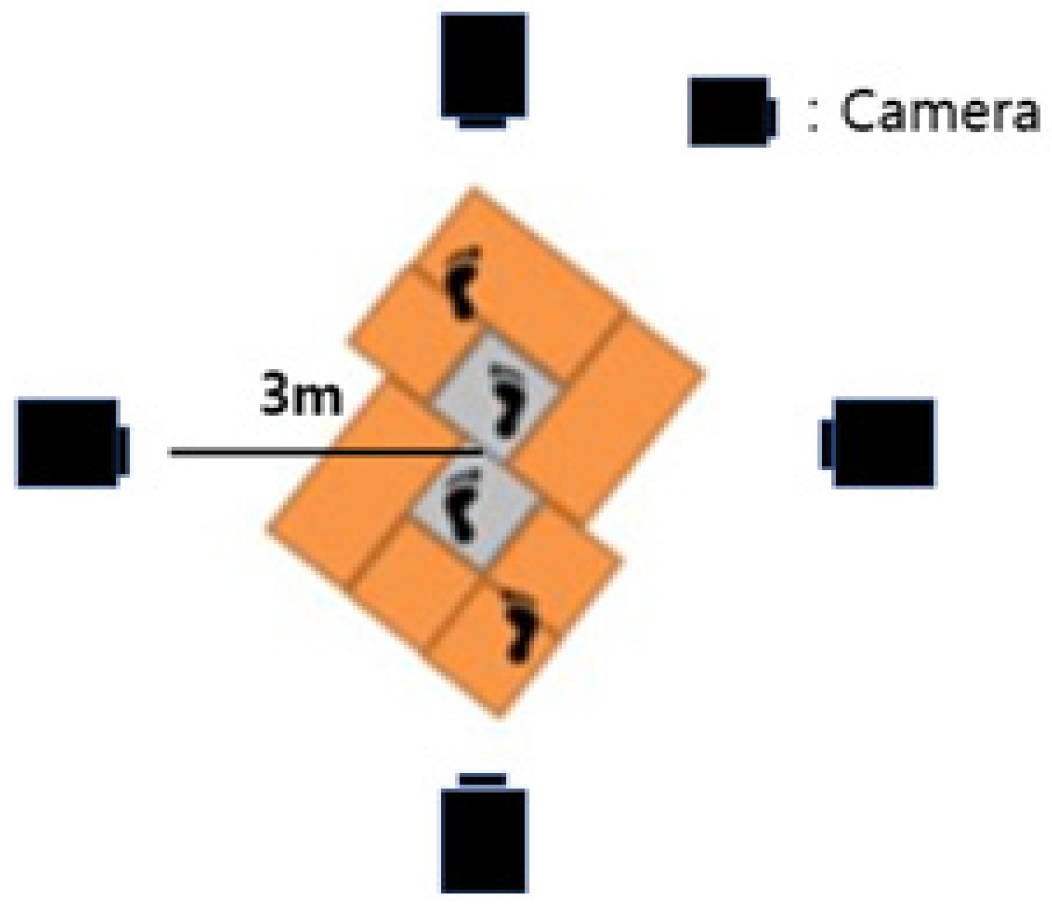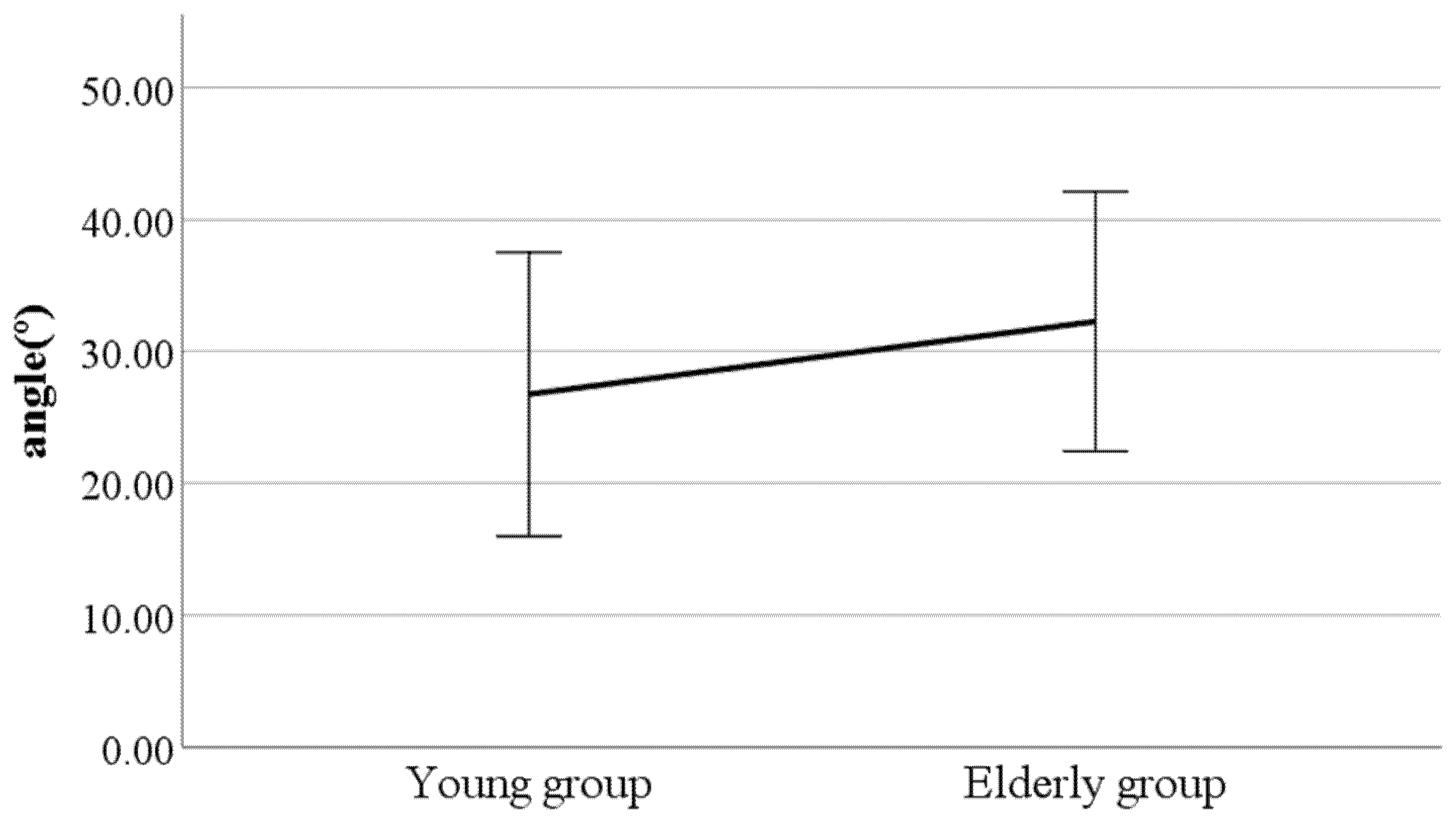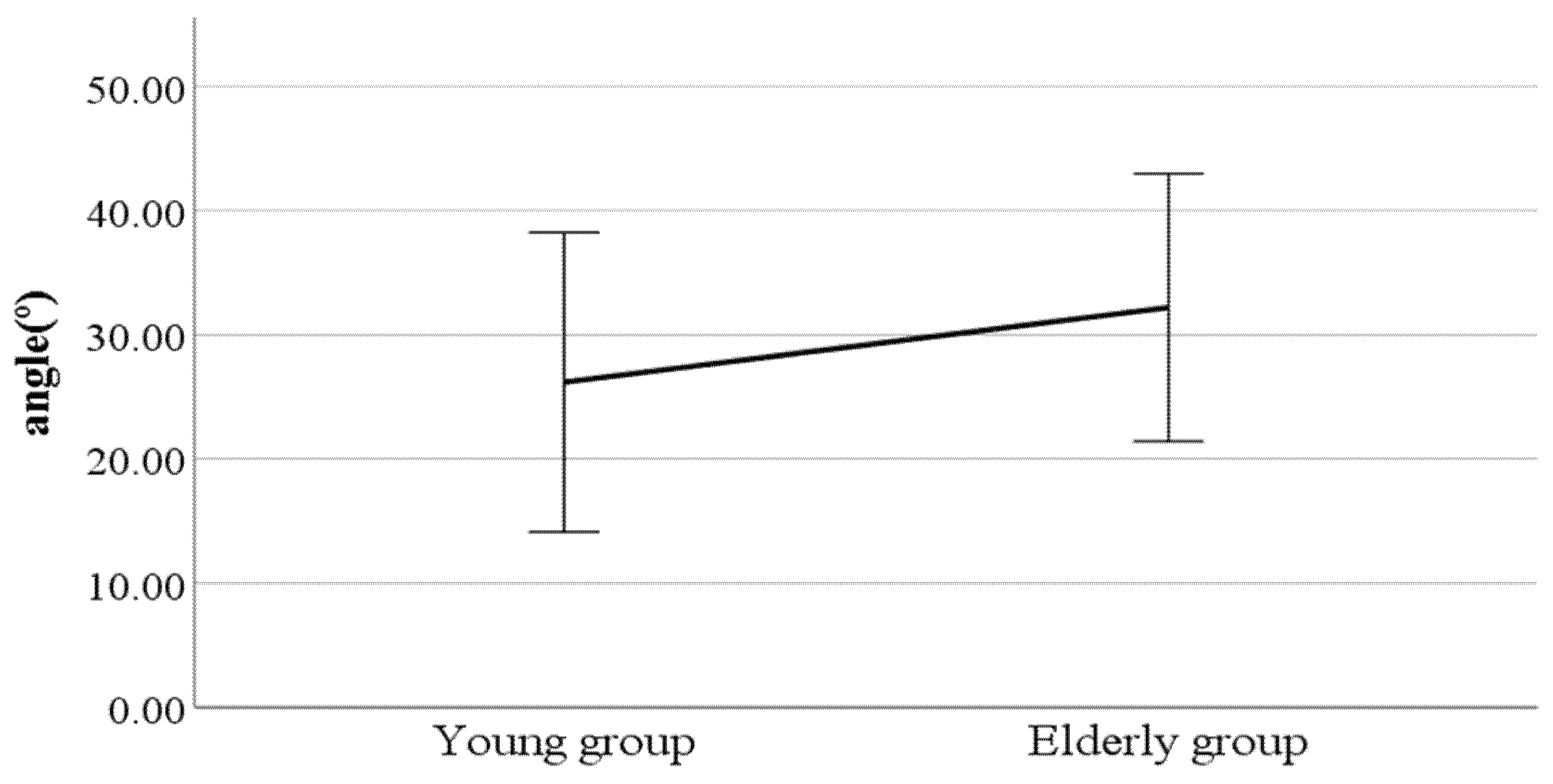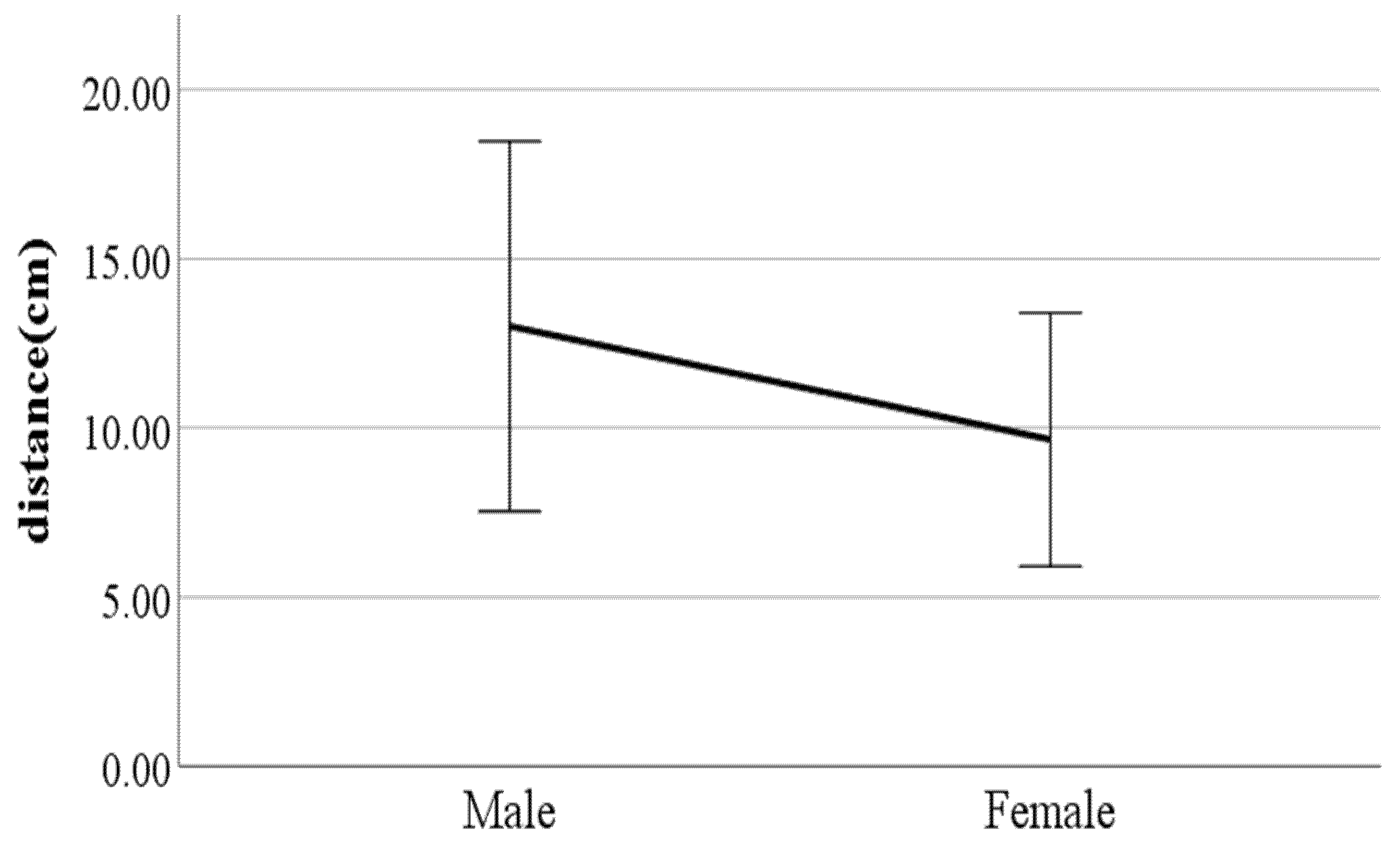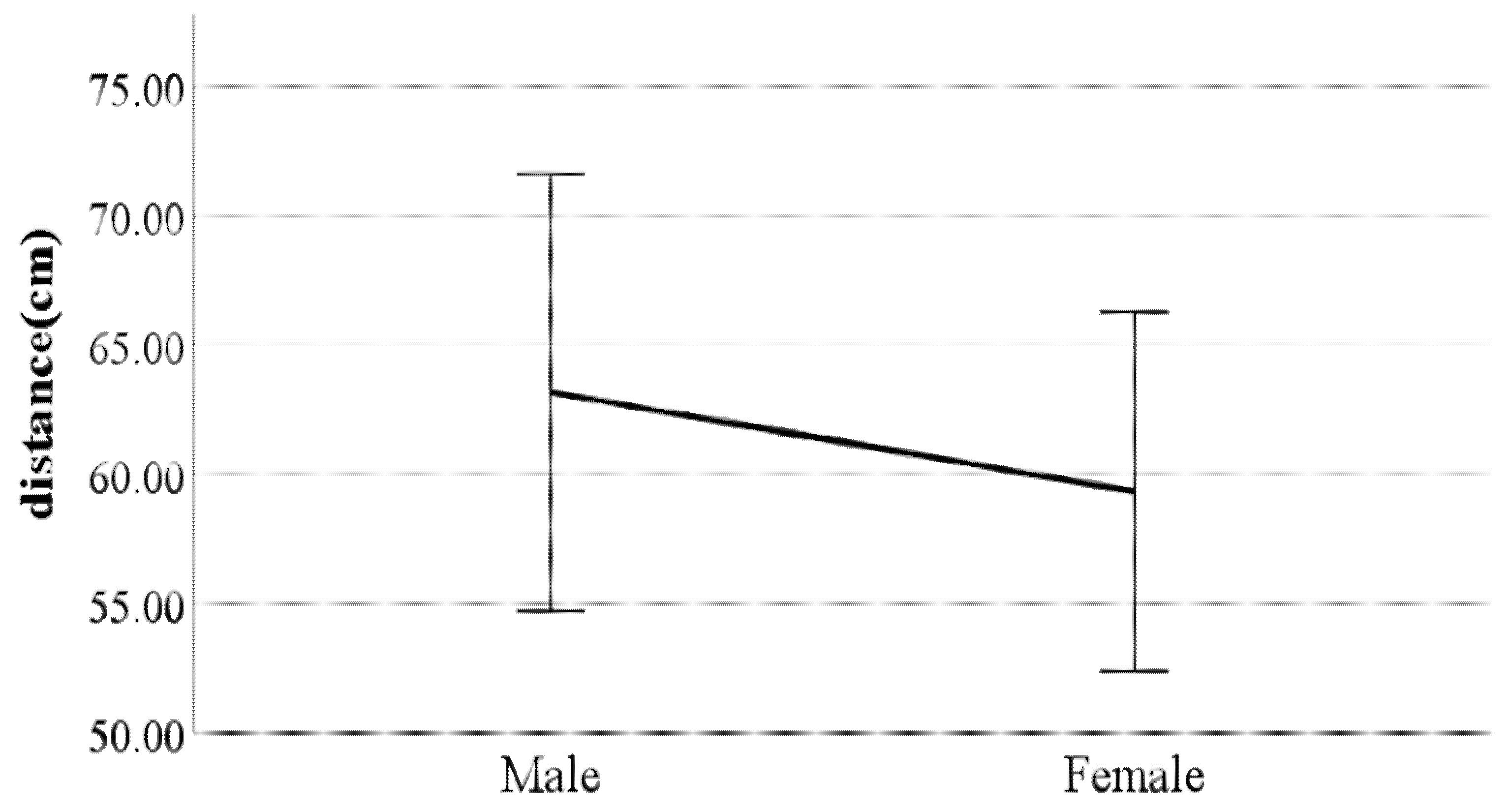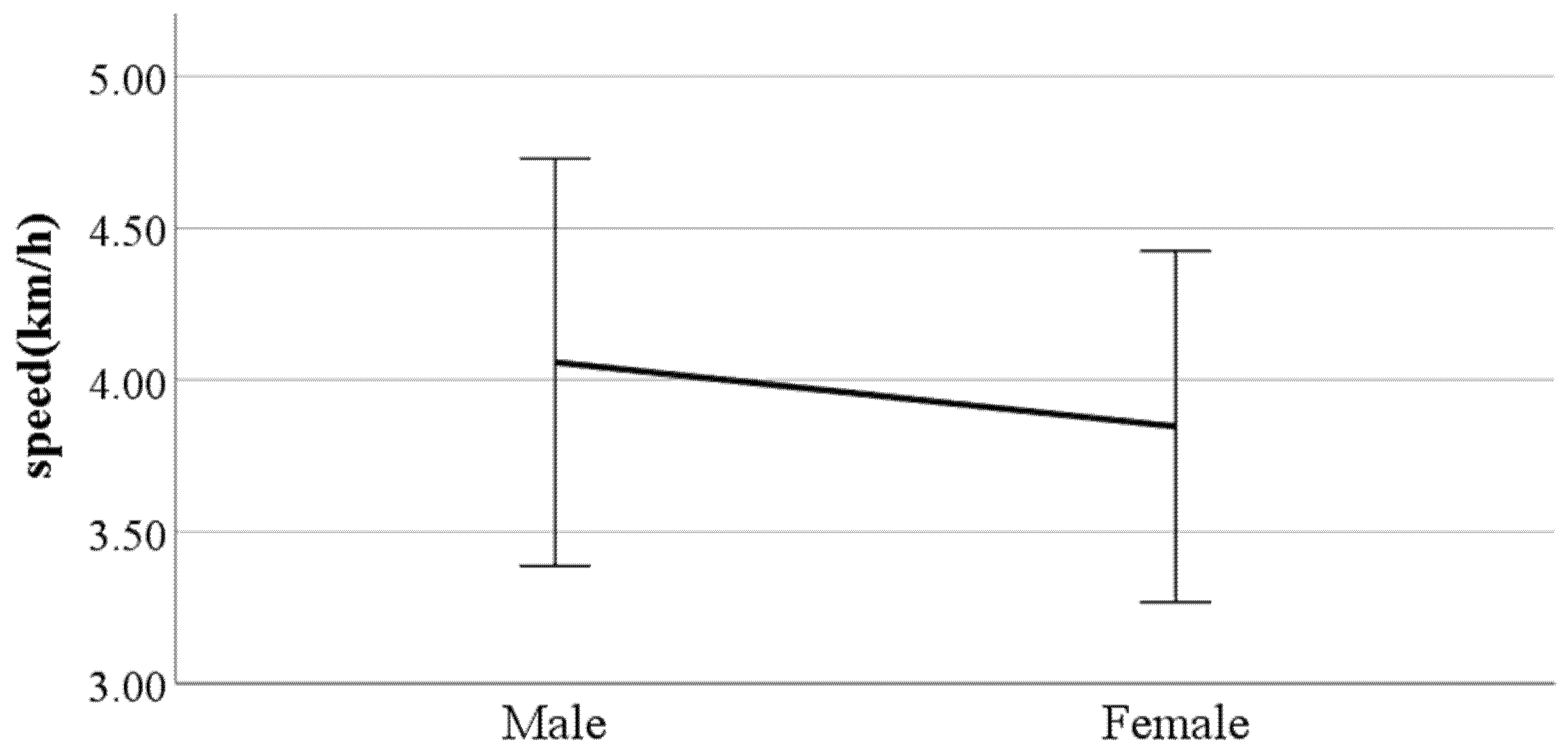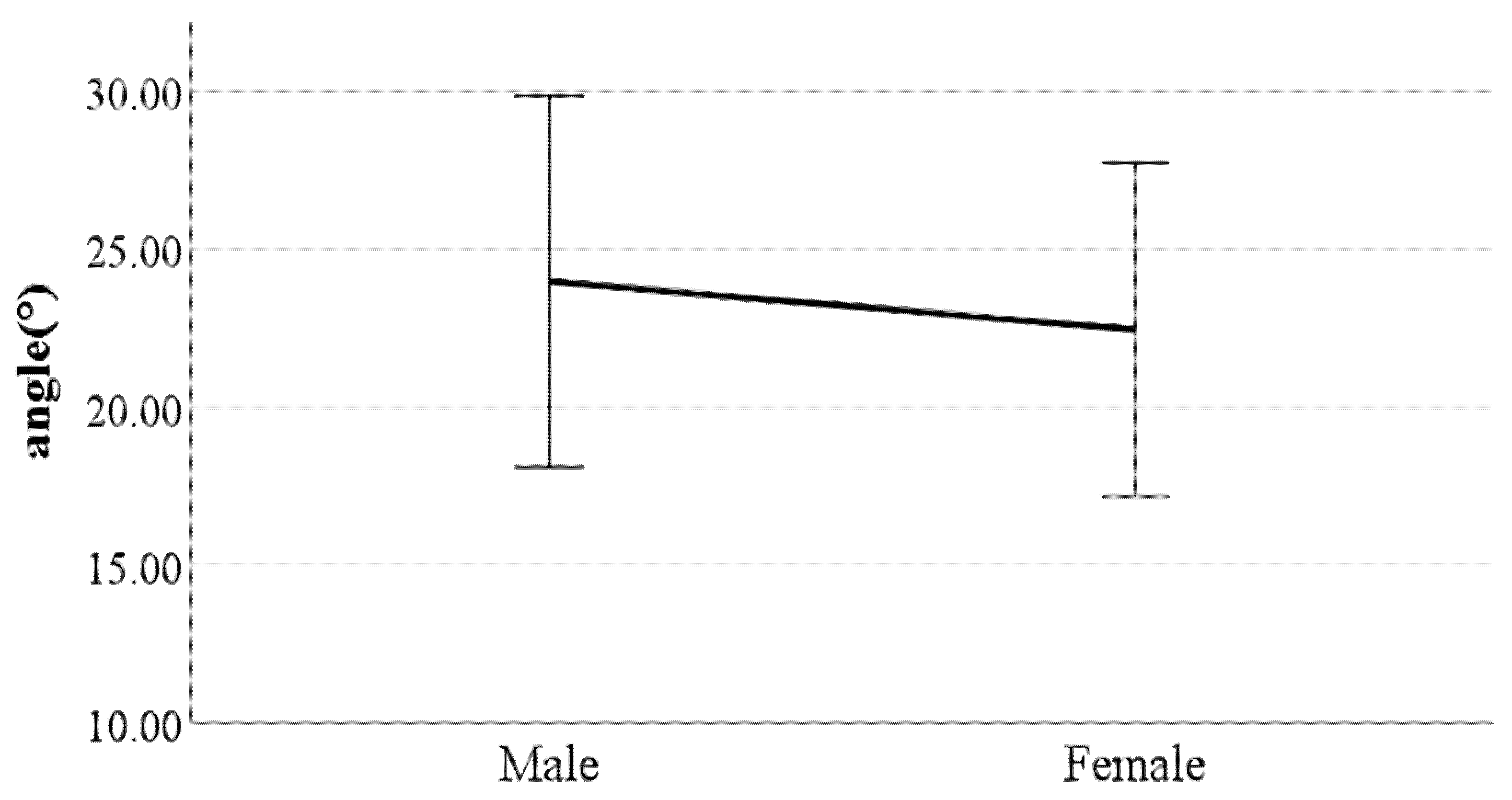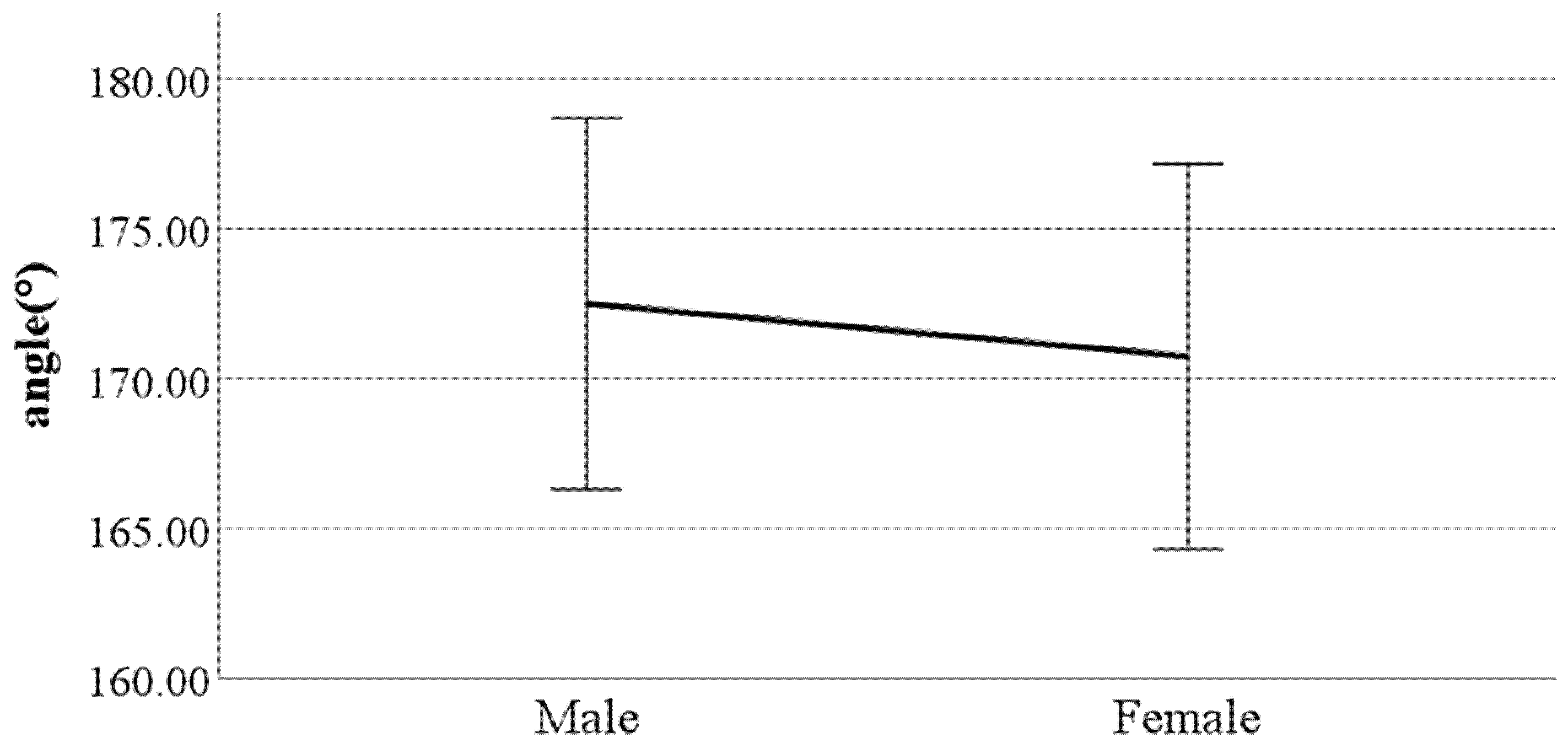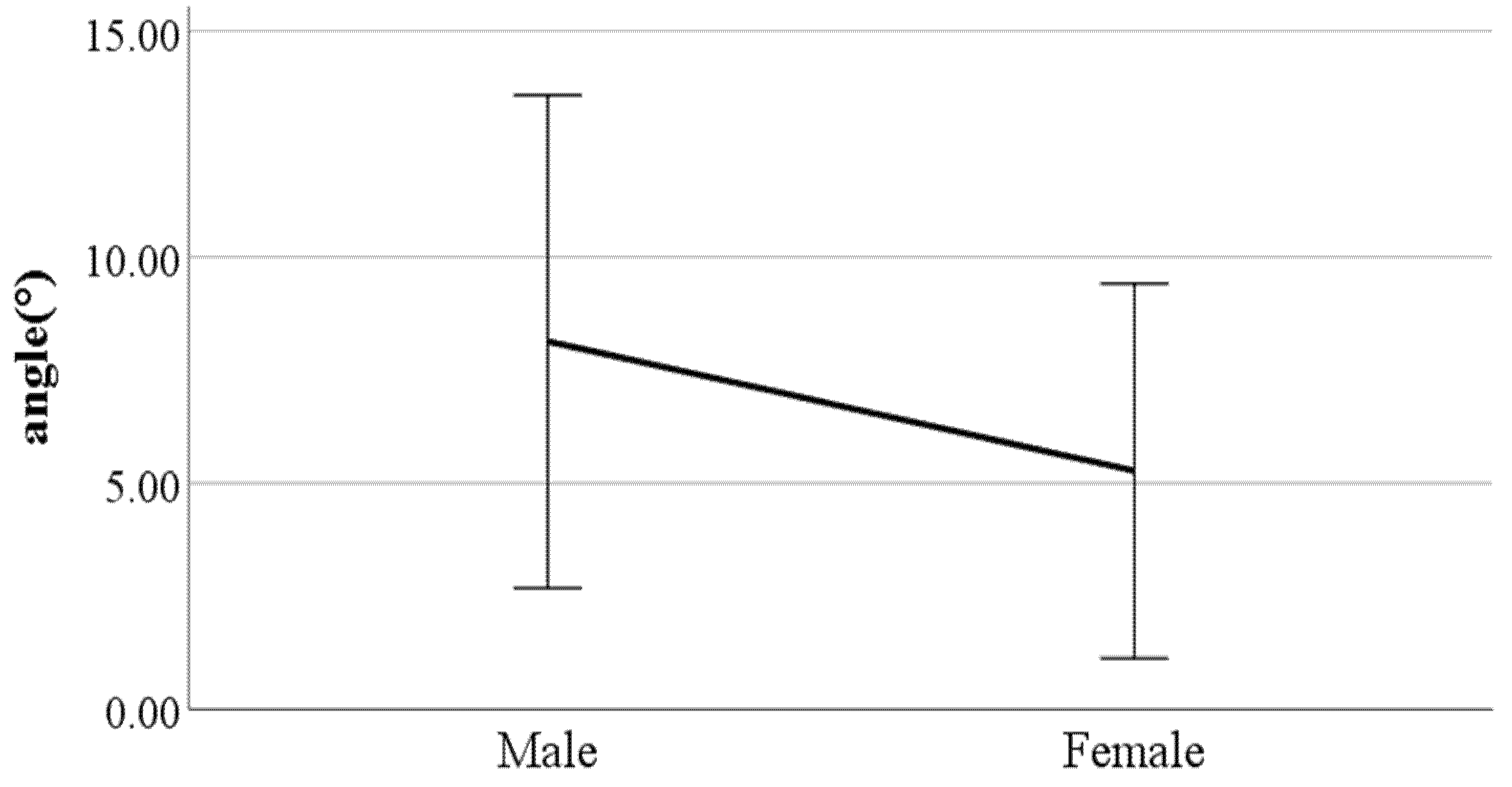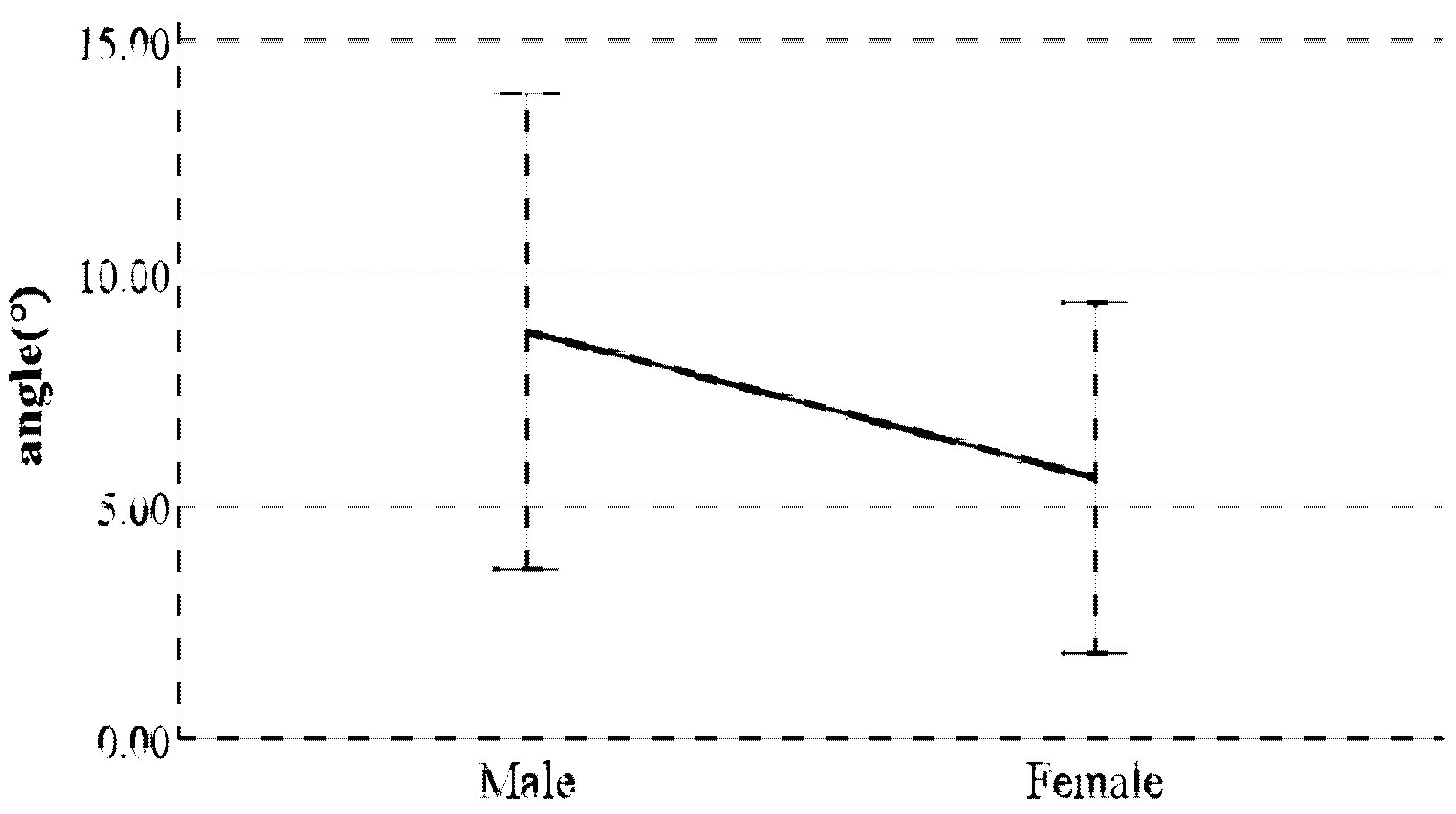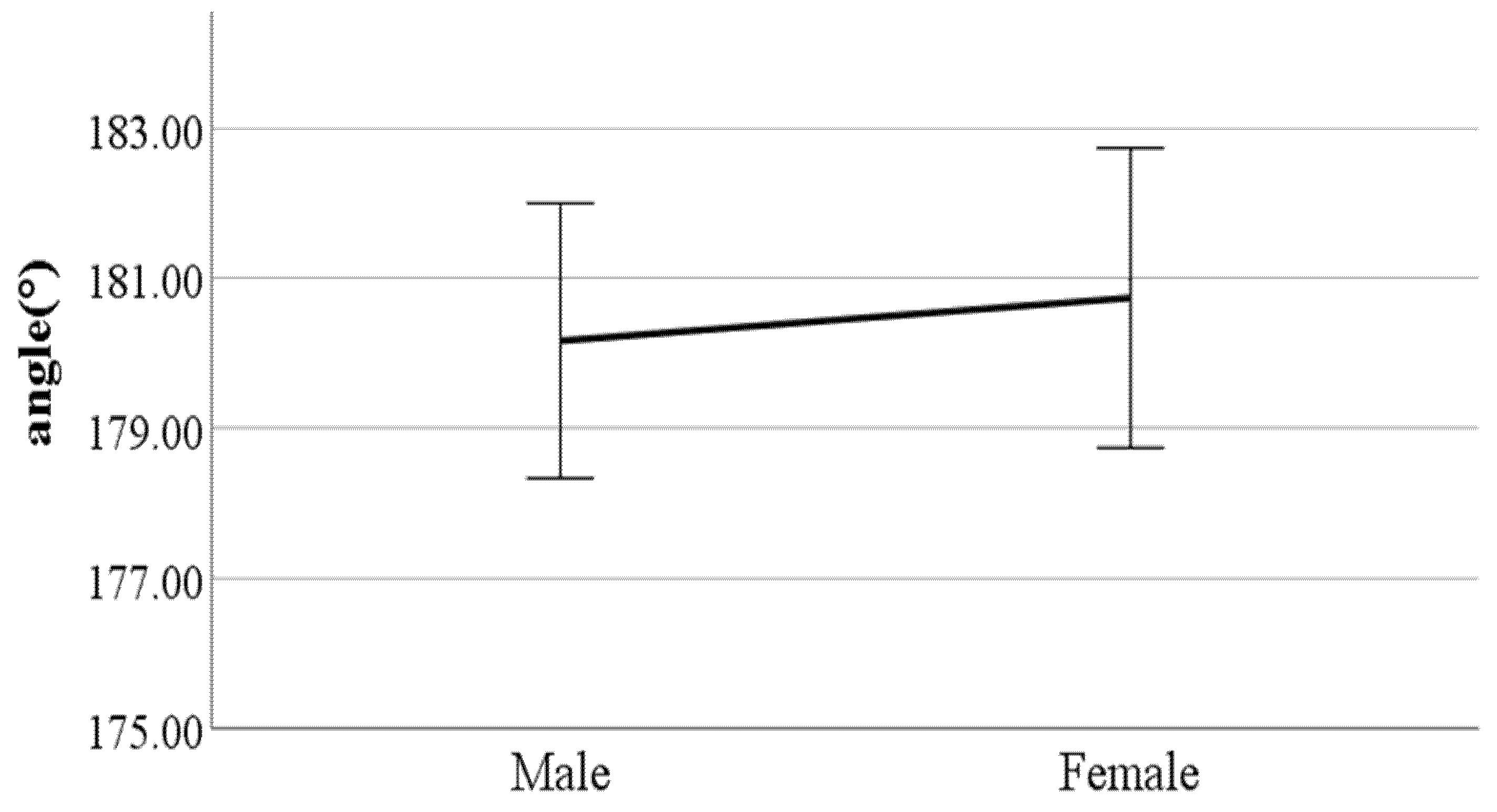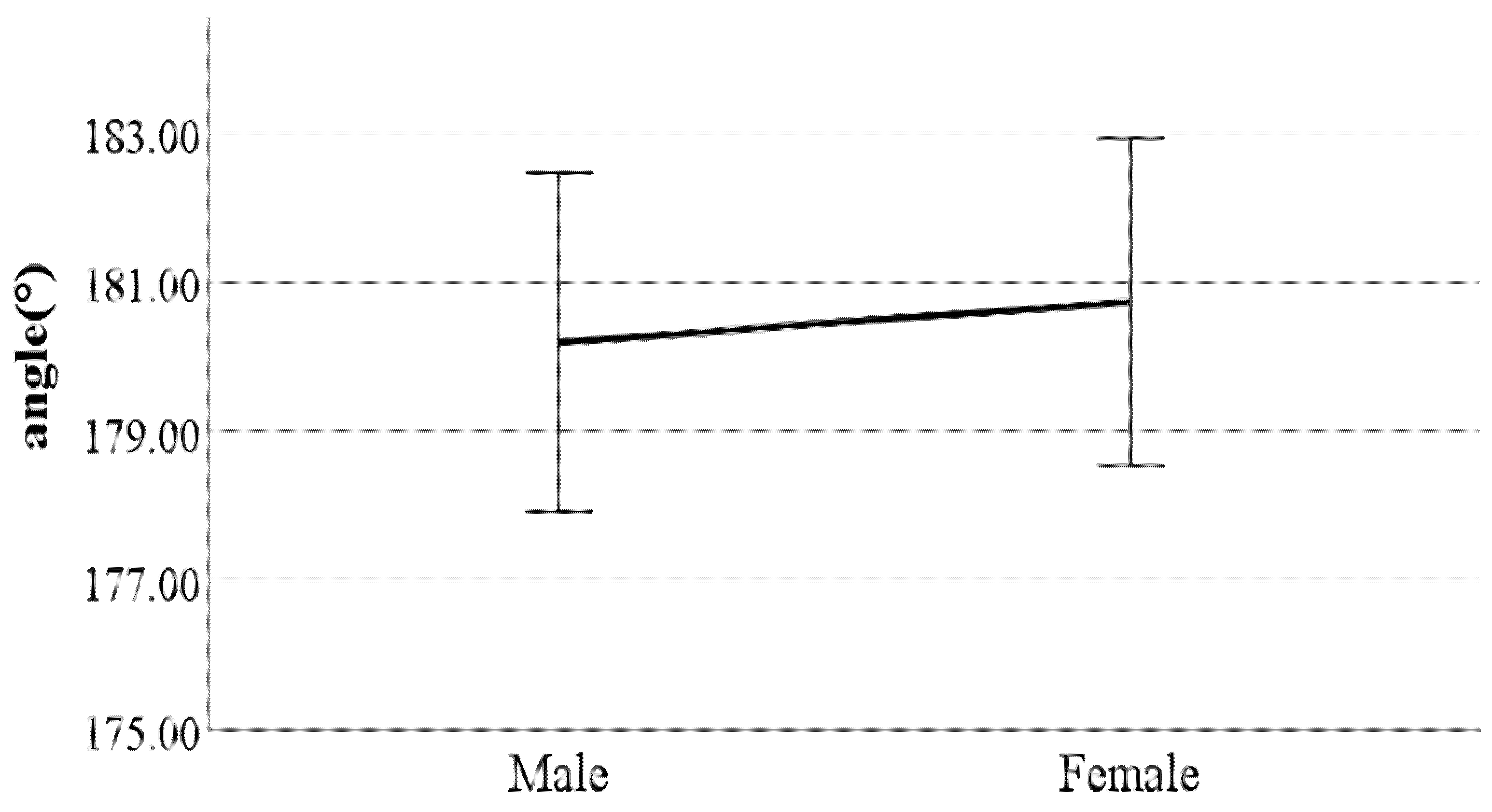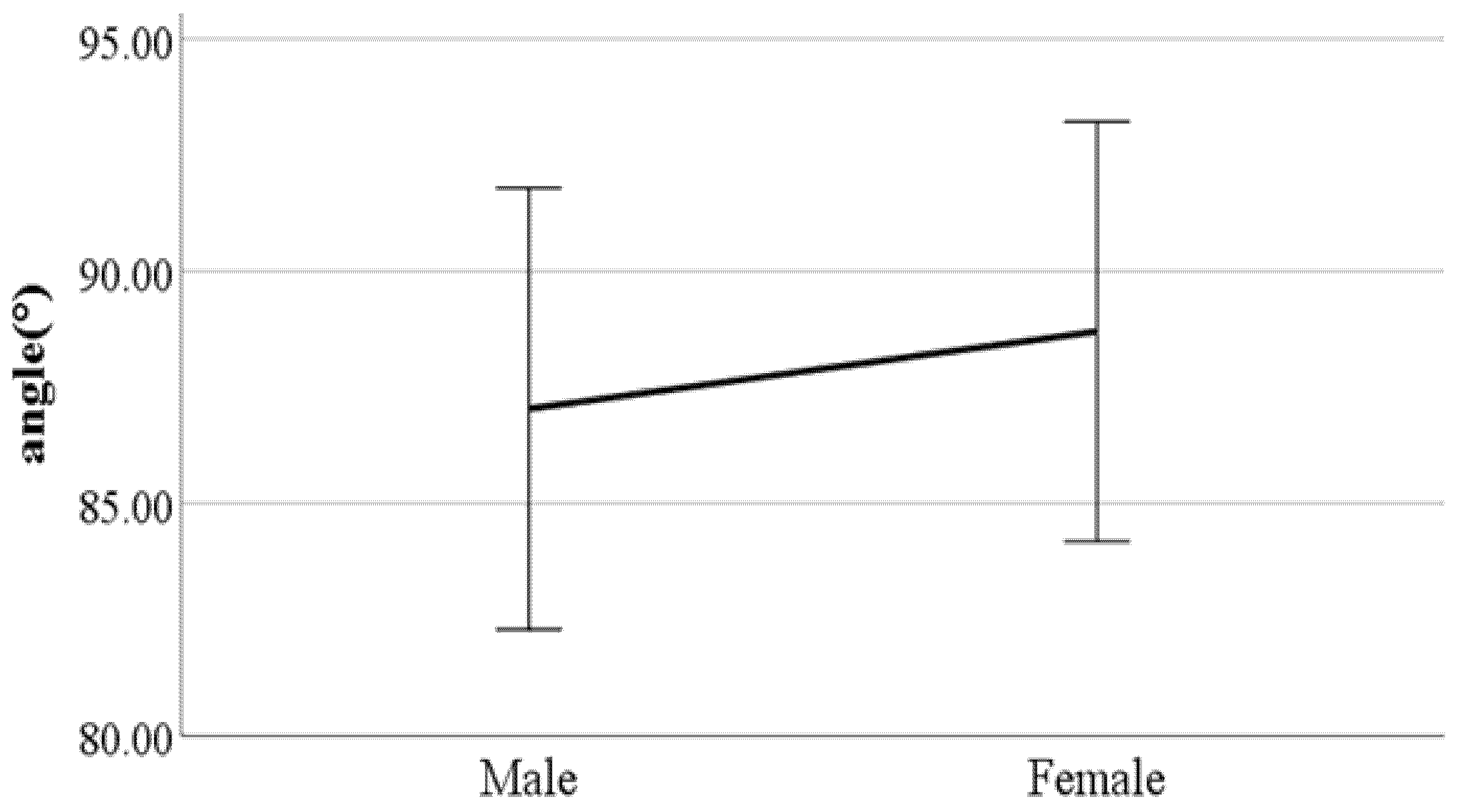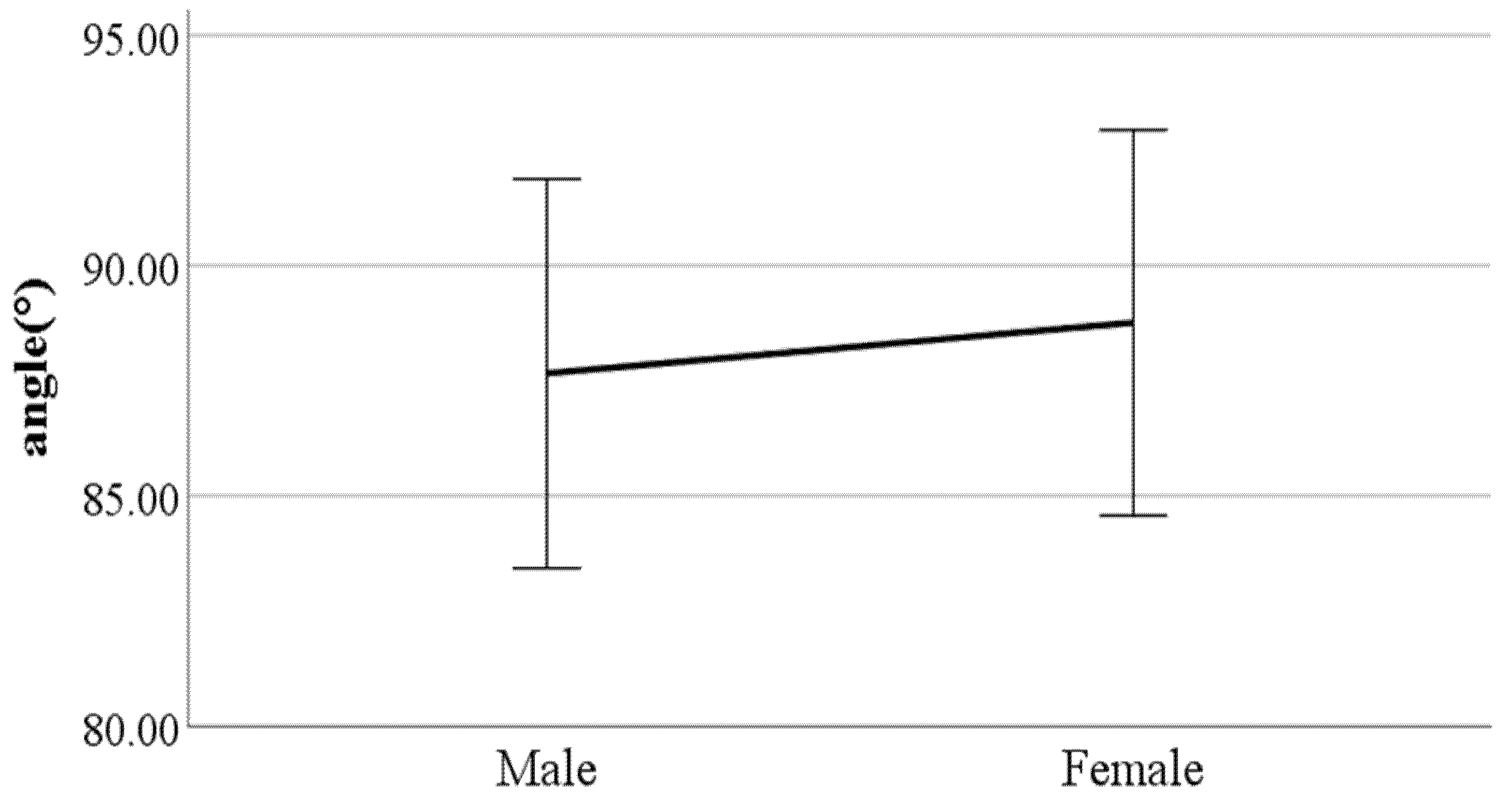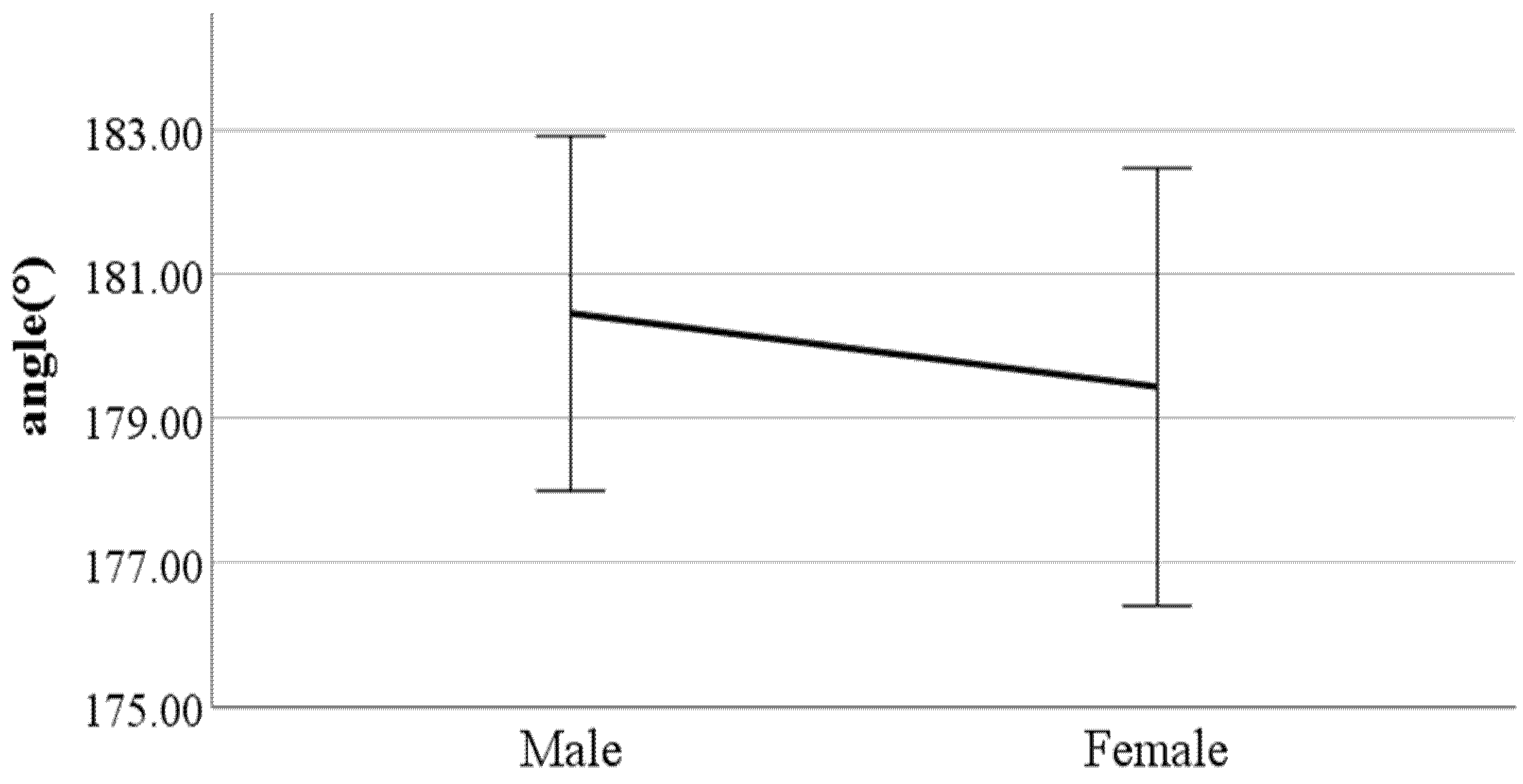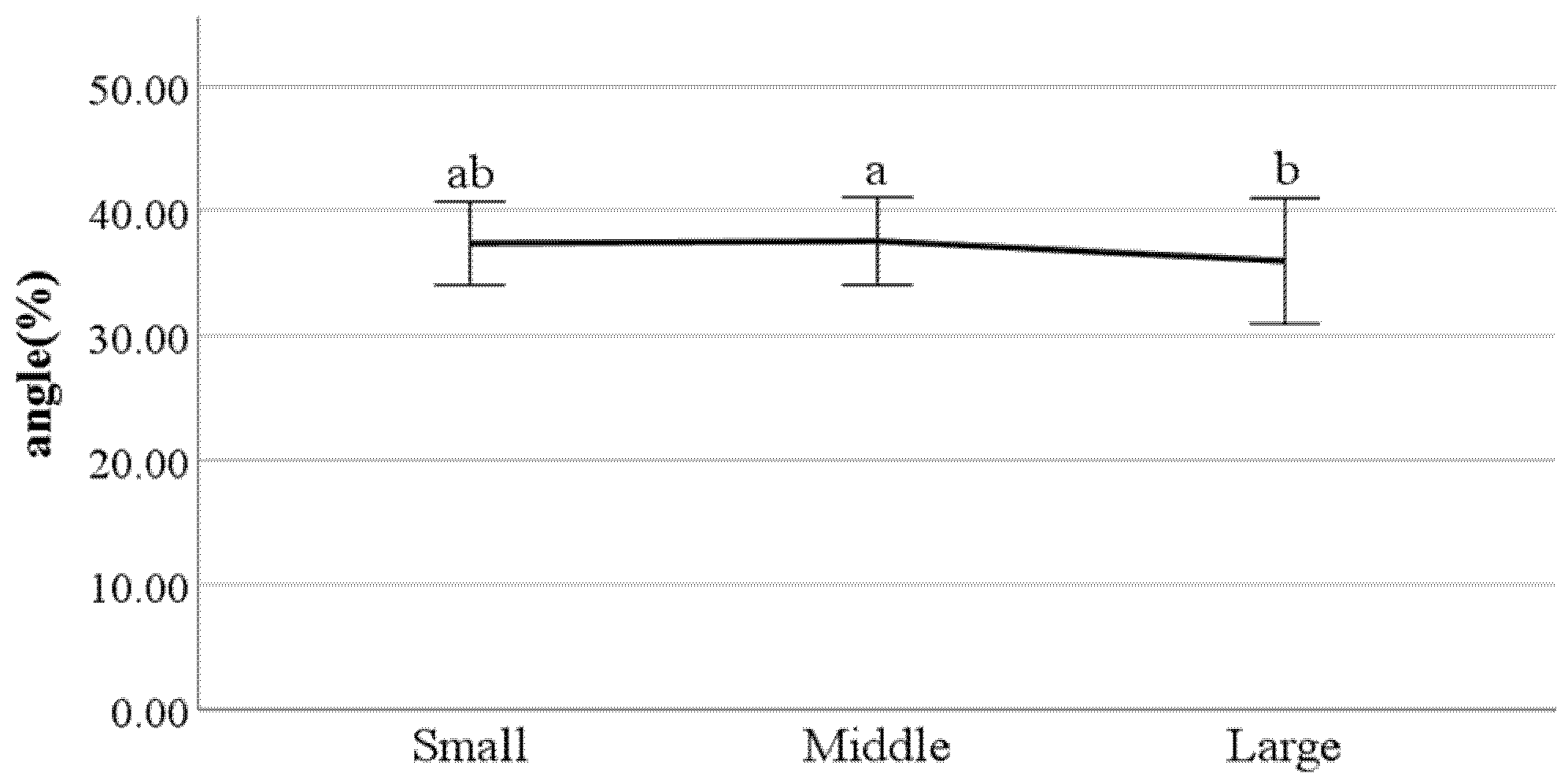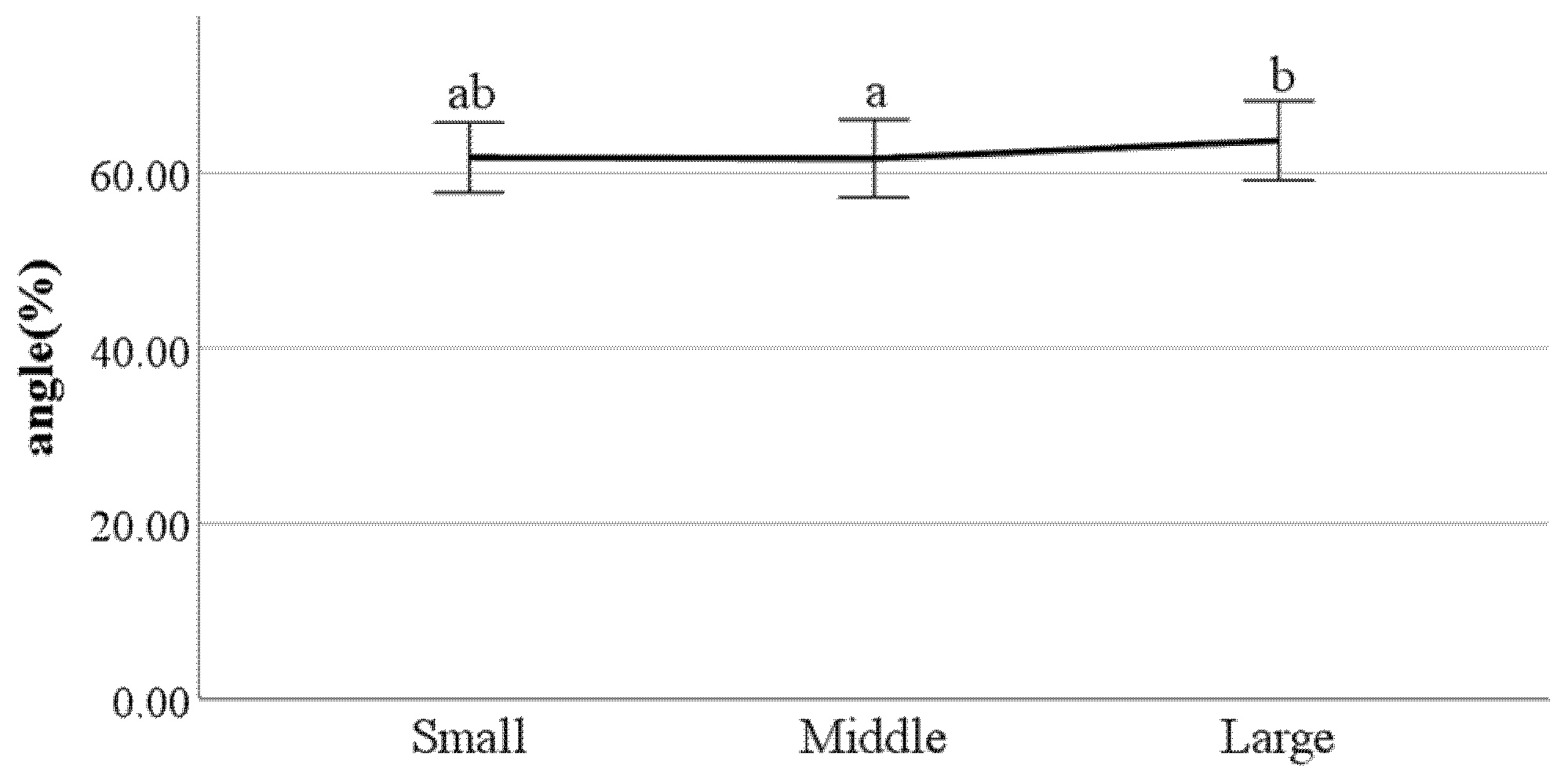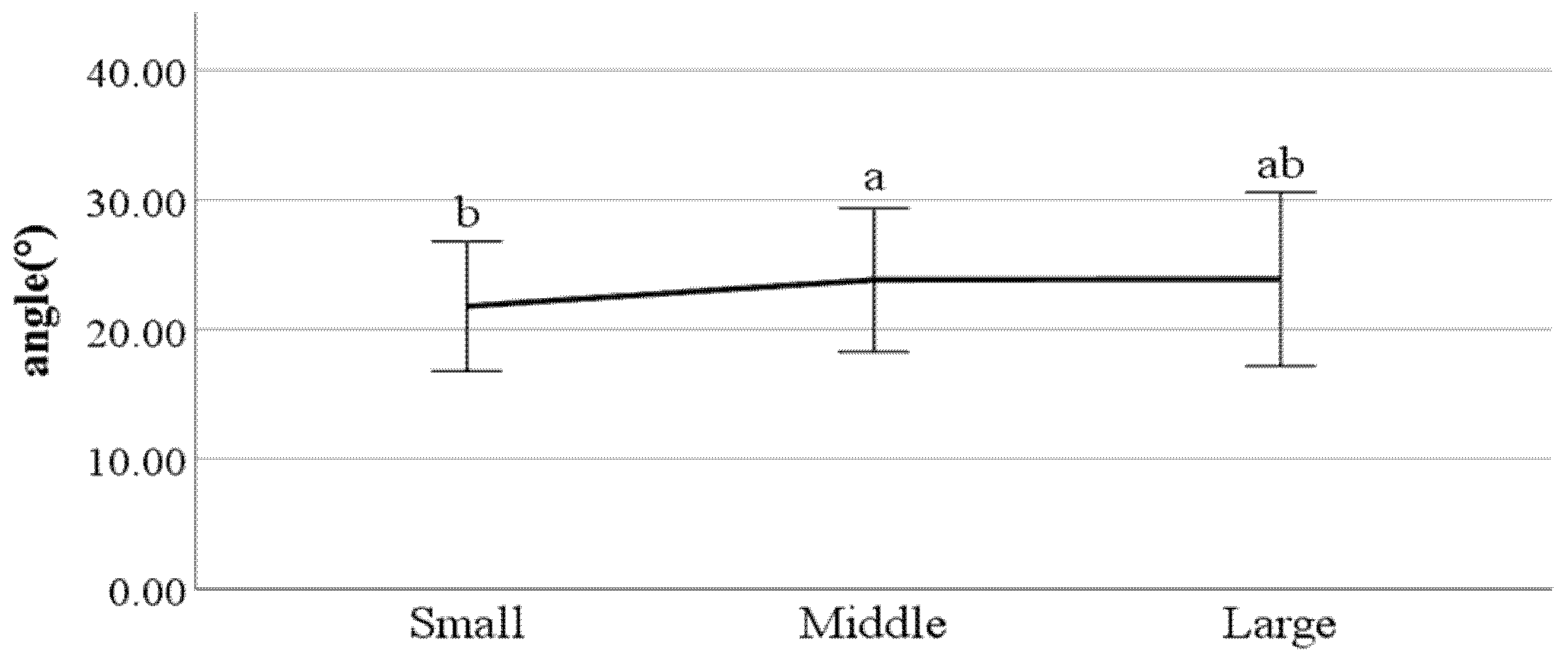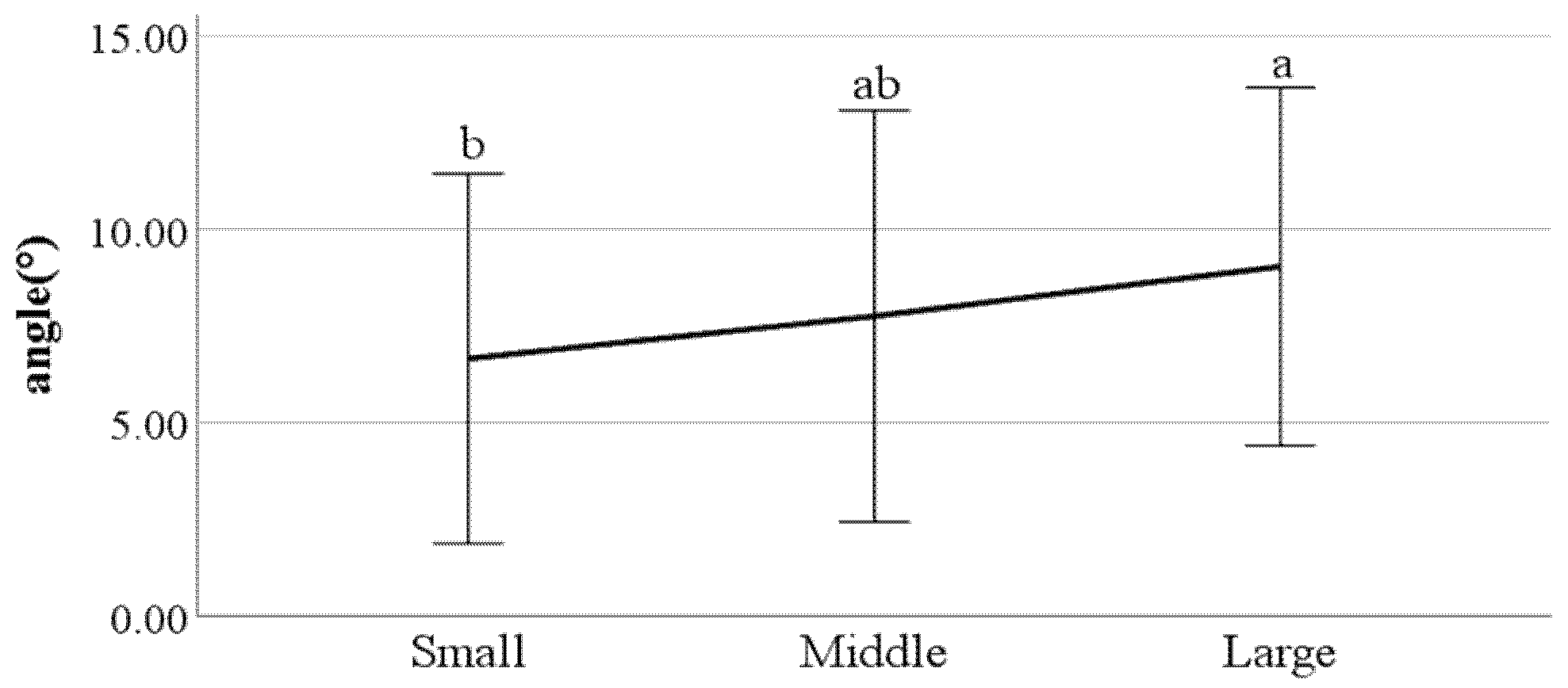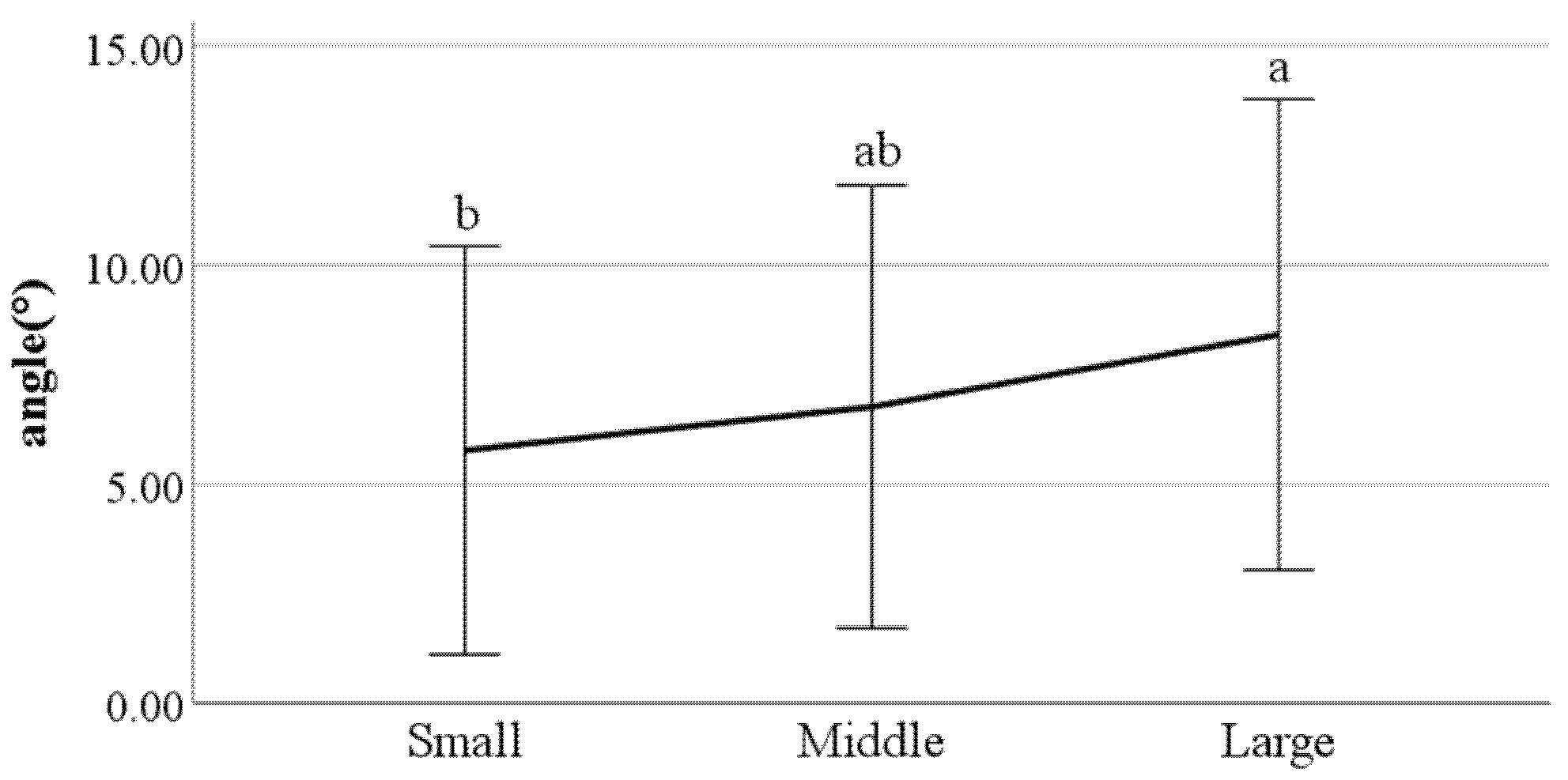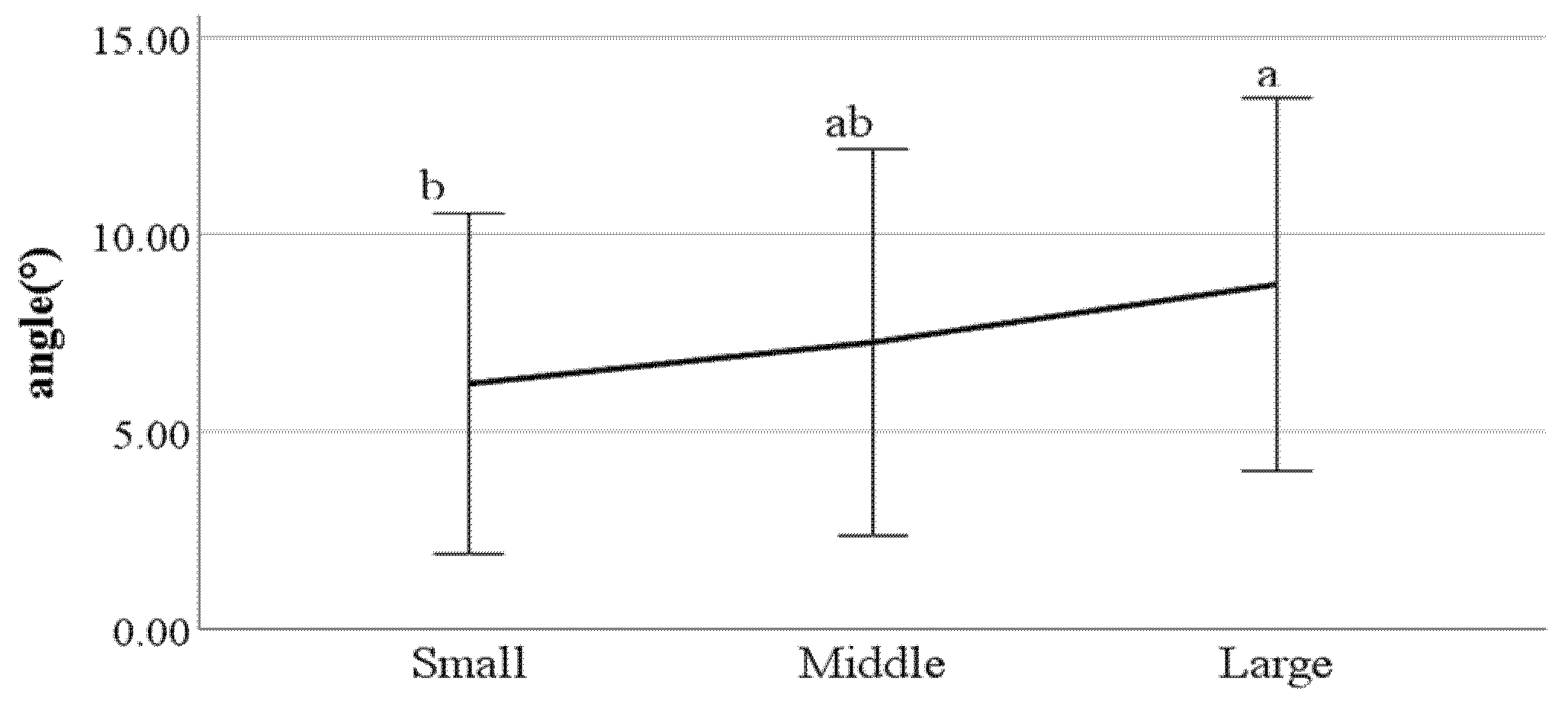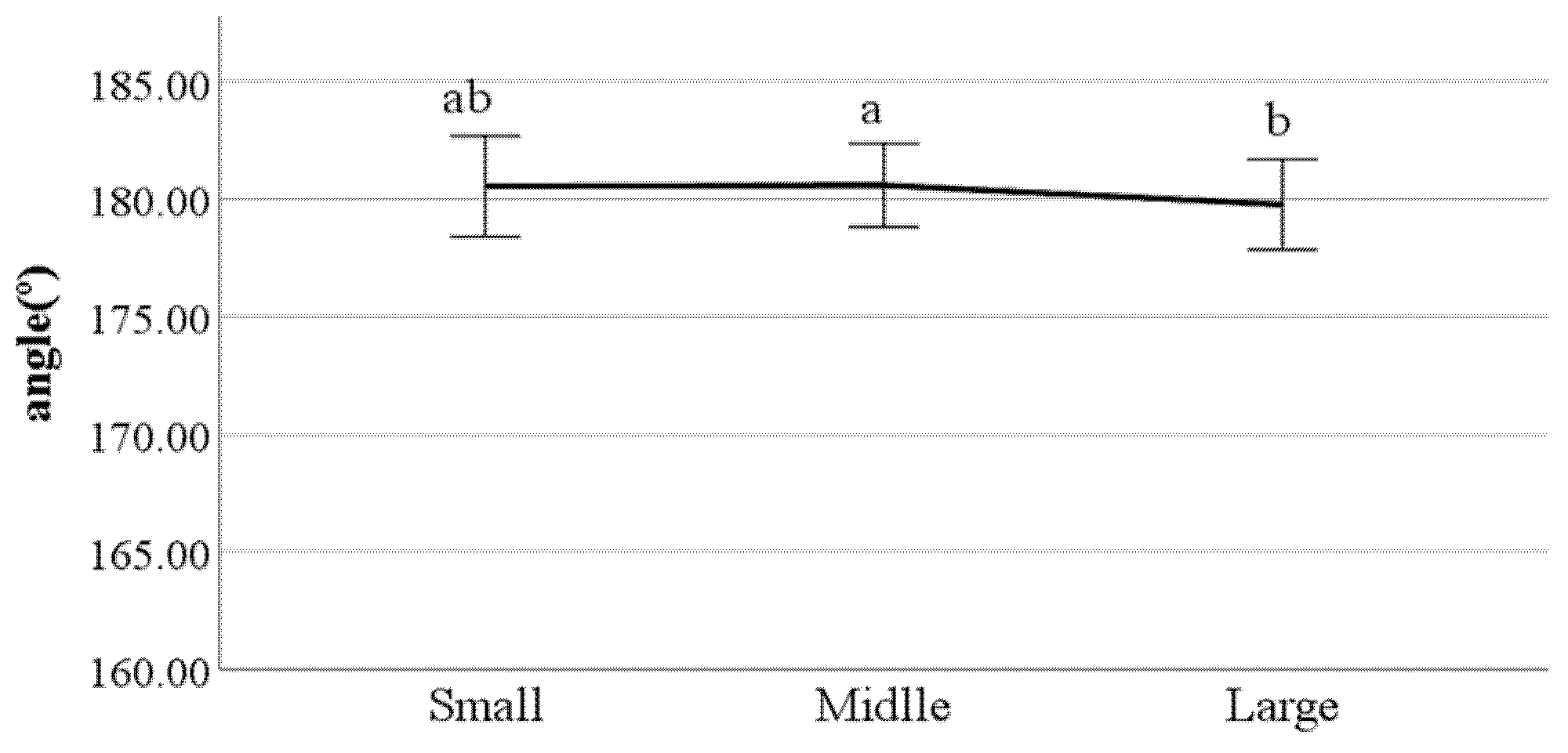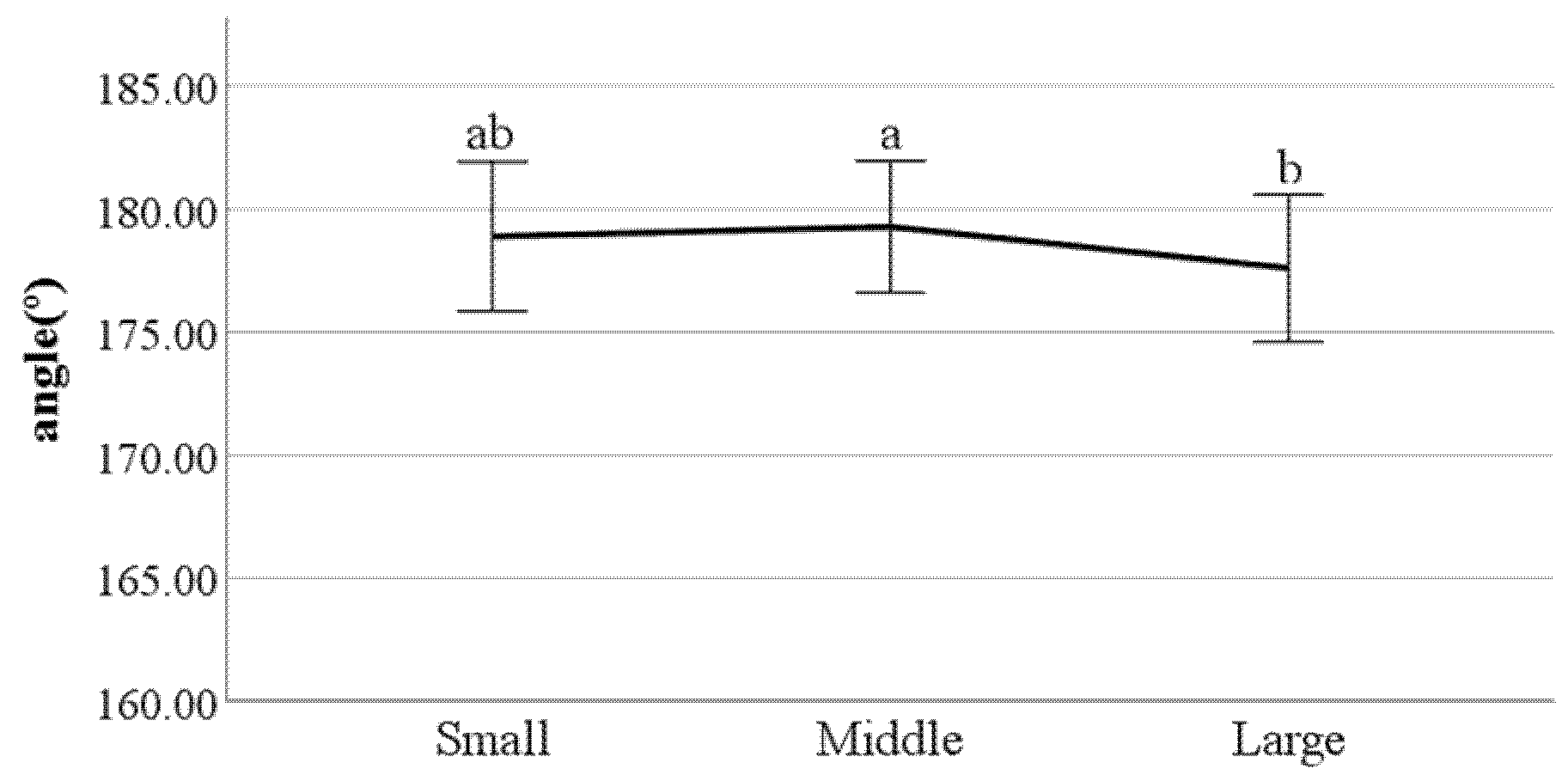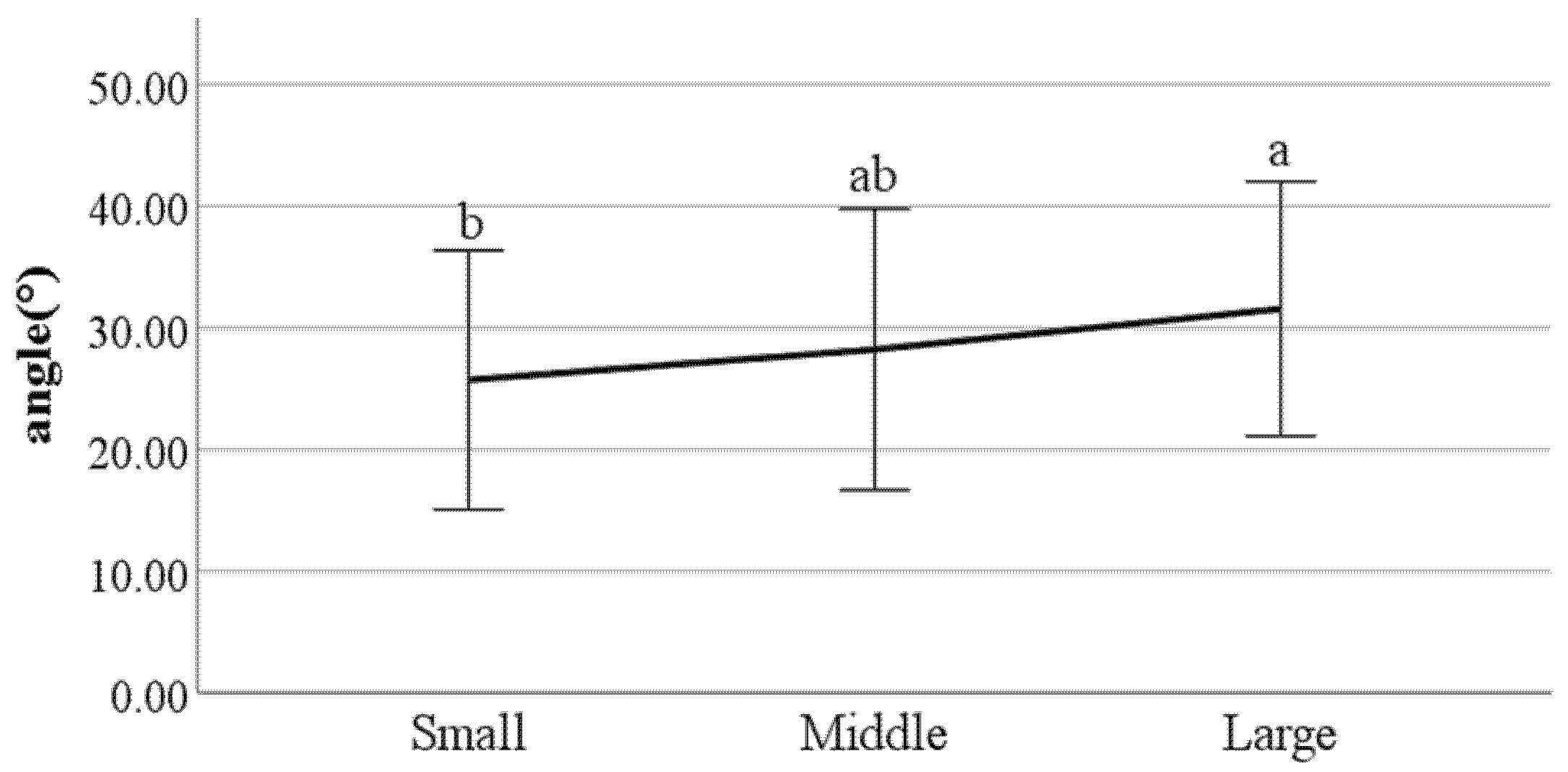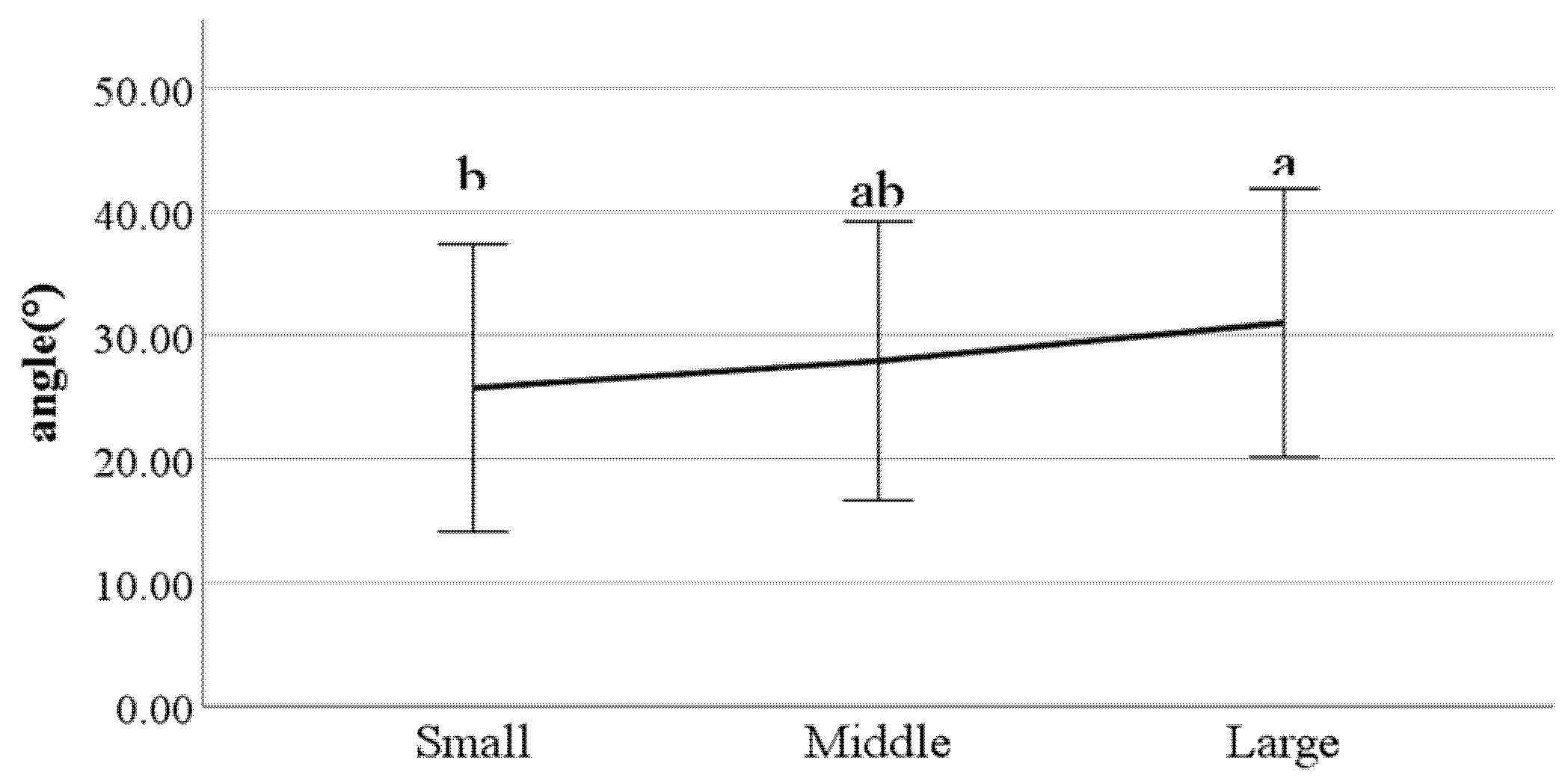Figure 1.
Experimental environment.
Figure 1.
Experimental environment.
Figure 2.
Age-to-age difference in double support phase (left foot forward) lateral flexion of the spinal column (F value: 2.31, DF: 289, p-value: 0.04).
Figure 2.
Age-to-age difference in double support phase (left foot forward) lateral flexion of the spinal column (F value: 2.31, DF: 289, p-value: 0.04).
Figure 3.
Age-to-age difference in heel-strike head movements in the sagittal plane (F value: 0.67, DF: 289, p-value: 0.00).
Figure 3.
Age-to-age difference in heel-strike head movements in the sagittal plane (F value: 0.67, DF: 289, p-value: 0.00).
Figure 4.
Age-to-age difference in toe-off head movements in the sagittal plane (F value: 3.04, DF: 289, p-value: 0.00).
Figure 4.
Age-to-age difference in toe-off head movements in the sagittal plane (F value: 3.04, DF: 289, p-value: 0.00).
Figure 5.
Age-to-age difference in mean head movements in the sagittal plane (F value: 2.88, DF: 289, p-value: 0.00).
Figure 5.
Age-to-age difference in mean head movements in the sagittal plane (F value: 2.88, DF: 289, p-value: 0.00).
Figure 6.
Gender difference in distance between the feet (F value: 13.40, DF: 289, p-value: 0.00).
Figure 6.
Gender difference in distance between the feet (F value: 13.40, DF: 289, p-value: 0.00).
Figure 7.
Gender difference in step length (F value: 5.78, DF: 289, p-value: 0.00).
Figure 7.
Gender difference in step length (F value: 5.78, DF: 289, p-value: 0.00).
Figure 8.
Gender difference in walking speed (F value: 3.58, DF: 289, p-value: 0.00).
Figure 8.
Gender difference in walking speed (F value: 3.58, DF: 289, p-value: 0.00).
Figure 9.
Gender difference in the ratio of swing phase (F value: 0.31, DF: 289, p-value: 0.04).
Figure 9.
Gender difference in the ratio of swing phase (F value: 0.31, DF: 289, p-value: 0.04).
Figure 10.
Gender difference in foot angle at heel-strike (F value: 0.82, DF: 289, p-value: 0.02).
Figure 10.
Gender difference in foot angle at heel-strike (F value: 0.82, DF: 289, p-value: 0.02).
Figure 11.
Gender difference in knee angle at heel-strike (F value: 2.39, DF: 289, p-value: 0.02).
Figure 11.
Gender difference in knee angle at heel-strike (F value: 2.39, DF: 289, p-value: 0.02).
Figure 12.
Gender difference in the flexion of the spinal column in the sagittal plane at heel-strike (F value: 11.29, DF: 289, p-value: 0.00).
Figure 12.
Gender difference in the flexion of the spinal column in the sagittal plane at heel-strike (F value: 11.29, DF: 289, p-value: 0.00).
Figure 13.
Gender difference in the flexion of the spinal column in the sagittal plane at toe-off (F value: 17.11, DF: 289, p-value: 0.00).
Figure 13.
Gender difference in the flexion of the spinal column in the sagittal plane at toe-off (F value: 17.11, DF: 289, p-value: 0.00).
Figure 14.
Gender difference in mean flexion of the spinal column in the sagittal plane (F value: 24.67, DF: 289, p-value: 0.00).
Figure 14.
Gender difference in mean flexion of the spinal column in the sagittal plane (F value: 24.67, DF: 289, p-value: 0.00).
Figure 15.
Gender difference in lateral trunk flexion at the double support phase (left foot forward (F value: 0.83, DF: 289, p-value: 0.01).
Figure 15.
Gender difference in lateral trunk flexion at the double support phase (left foot forward (F value: 0.83, DF: 289, p-value: 0.01).
Figure 16.
Gender difference in lateral trunk flexion at the double support phase (right foot forward) (F value: 0.01, DF: 289, p-value: 0.04).
Figure 16.
Gender difference in lateral trunk flexion at the double support phase (right foot forward) (F value: 0.01, DF: 289, p-value: 0.04).
Figure 17.
Gender difference in forward, backward trunk bending at heel-strike (F value: 0.19, DF: 289, p-value: 0.00).
Figure 17.
Gender difference in forward, backward trunk bending at heel-strike (F value: 0.19, DF: 289, p-value: 0.00).
Figure 18.
Gender difference in mean forward/backward trunk bending (F value: 0.22, DF: 289, p-value: 0.03).
Figure 18.
Gender difference in mean forward/backward trunk bending (F value: 0.22, DF: 289, p-value: 0.03).
Figure 19.
Gender difference in shoulder angle in the frontal plane at the double support phase (left foot forward) (F value: 4.72, DF: 289, p-value: 0.00).
Figure 19.
Gender difference in shoulder angle in the frontal plane at the double support phase (left foot forward) (F value: 4.72, DF: 289, p-value: 0.00).
Figure 20.
Gender difference in head movements in the frontal plane at the double support phase (left foot forward) (F value: 3.37, DF: 289, p-value: 0.02).
Figure 20.
Gender difference in head movements in the frontal plane at the double support phase (left foot forward) (F value: 3.37, DF: 289, p-value: 0.02).
Figure 21.
Gender difference in head movements in the frontal plane at the double support phase (right foot forward) (F value: 0.03, DF: 289, p-value: 0.04).
Figure 21.
Gender difference in head movements in the frontal plane at the double support phase (right foot forward) (F value: 0.03, DF: 289, p-value: 0.04).
Figure 22.
Distance between the feet (F value: 0.08, DF: 2, p-value: 0.00).
Figure 22.
Distance between the feet (F value: 0.08, DF: 2, p-value: 0.00).
Figure 23.
Swing phase of left foot (F value: 4.56, DF: 2, p-value: 0.01).
Figure 23.
Swing phase of left foot (F value: 4.56, DF: 2, p-value: 0.01).
Figure 24.
The ratio of swing phase of right foot (F value: 3.17, DF: 2, p-value: 0.04).
Figure 24.
The ratio of swing phase of right foot (F value: 3.17, DF: 2, p-value: 0.04).
Figure 25.
The ratio of stance phase of left foot (F value: 3.93, DF: 2, p-value: 0.02).
Figure 25.
The ratio of stance phase of left foot (F value: 3.93, DF: 2, p-value: 0.02).
Figure 26.
The ratio of stance phase of right foot (F value: 3.12, DF: 2, p-value: 0.04).
Figure 26.
The ratio of stance phase of right foot (F value: 3.12, DF: 2, p-value: 0.04).
Figure 27.
Foot angle at heel-strike (F value: 4.19, DF: 2, p-value: 0.02).
Figure 27.
Foot angle at heel-strike (F value: 4.19, DF: 2, p-value: 0.02).
Figure 28.
Flexion of the spinal column in the sagittal plane at heel-strike f (F value: 3.39, DF: 2, p-value: 0.04).
Figure 28.
Flexion of the spinal column in the sagittal plane at heel-strike f (F value: 3.39, DF: 2, p-value: 0.04).
Figure 29.
Flexion of the spinal column in the sagittal plane at toe-off (F value: 4.14, DF: 2, p-value: 0.02).
Figure 29.
Flexion of the spinal column in the sagittal plane at toe-off (F value: 4.14, DF: 2, p-value: 0.02).
Figure 30.
Mean flexion of the spinal column in the sagittal plane (F value: 4.29, DF: 2, p-value: 0.02).
Figure 30.
Mean flexion of the spinal column in the sagittal plane (F value: 4.29, DF: 2, p-value: 0.02).
Figure 31.
Lateral trunk flexion at the double support phase (left foot forward) (F value: 3.19, DF: 2, p-value: 0.04).
Figure 31.
Lateral trunk flexion at the double support phase (left foot forward) (F value: 3.19, DF: 2, p-value: 0.04).
Figure 32.
Lateral trunk flexion at the double support phase (right foot forward) (F value: 3.10, DF: 2, p-value: 0.04).
Figure 32.
Lateral trunk flexion at the double support phase (right foot forward) (F value: 3.10, DF: 2, p-value: 0.04).
Figure 33.
Head movements in the frontal plane at the double support phase (left foot forward) (F value: 5.90, DF: 2, p-value: 0.00).
Figure 33.
Head movements in the frontal plane at the double support phase (left foot forward) (F value: 5.90, DF: 2, p-value: 0.00).
Figure 34.
Head movements in the sagittal plane at heel-strike (F value: 4.13, DF: 2, p-value: 0.02).
Figure 34.
Head movements in the sagittal plane at heel-strike (F value: 4.13, DF: 2, p-value: 0.02).
Figure 35.
Mean head movements in the sagittal plane at heel-strike (F value: 3.21, DF: 2, p-value: 0.04).
Figure 35.
Mean head movements in the sagittal plane at heel-strike (F value: 3.21, DF: 2, p-value: 0.04).
Table 1.
Major gait parameters previously studied.
Table 1.
Major gait parameters previously studied.
| Gait Parameters | Previous Studies |
|---|
| Distance between the feet | Larsen, Simonsen, and Lynnerup, 2008 [10], Birch, Vernon, Walker, and Young, 2015 [14] |
| Step length | Birch, Vernon, Walker, and Young, 2015 [14], Prakash, Kumar, and Mittal, 2016 [11] |
| Number of steps per minute | Birch, Vernon, Walker, and Young, 2015 [14], Prakash, Kumar, and Mittal, 2016 [11] |
| Walking speed | Birch, Vernon, Walker, and Young, 2015 [14], Prakash, Kumar, and Mittal, 2016 [11] |
| Swing/Stance phase | Prakash, Kumar, and Mittal, 2016 [11] |
| Foot angle | Larsen, Simonsen, and Lynnerup, 2008 [10] |
| Knee angle | Larsen, Simonsen, and Lynnerup, 2008 [10] |
| Flexion of the spinal column in the sagittal plane | Larsen, Simonsen, and Lynnerup, 2008 [10] |
| Forward/Backward bending of upper body | Larsen, Simonsen, and Lynnerup, 2008 [10] |
| Rotation of the upper body | Larsen, Simonsen, and Lynnerup, 2008 [10] |
| Shoulder angle in the frontal plane | Larsen, Simonsen, and Lynnerup, 2008 [10] |
| Head movements in the sagittal plane | Larsen, Simonsen, and Lynnerup, 2008 [10] |
| Head movements in the frontal plane | Larsen, Simonsen, and Lynnerup, 2008 [10] |
| Toe-in gait/Toe-out gait | Birch, Vernon, Walker, and Young, 2015 [14] |
| Pelvis Abduction/Adduction | Larsen, Simonsen, and Lynnerup, 2008 [10] |
| Knee Varus⁄Valgus | Larsen, Simonsen, and Lynnerup, 2008 [10] |
Table 2.
Definition and derivation method of gait parameters of the lower body.
Table 2.
Definition and derivation method of gait parameters of the lower body.
| Gait Parameters | Definition and Derivation Method |
|---|
| Distance between the feet | Definition: The distance between the centers of both feet.Derivation method: Derive from the captured image of the frontal plane at the double support moment. Calculate the horizontal distance of two feet based on the ratio of the image and the actual distance. |
| Step length | Definition: Distance between end-points of the front foot and back foot.Derivation method: Derive from the captured image of the sagittal plane at the toe-off moment. Draw a line between the end-points of the front foot and the back foot, then measure it in consideration of the ratio of the image and the actual distance. |
| Number of steps per minute | Definition: Number of steps per minute.Derivation Method: Calculate the number of steps taken in the total walk and divide it by the time taken. |
| Walking speed | Definition: Distance traveled per hour.Derivation method: Calculate the ratio of total walking distance to time. |
| The ratio of swing phase of left/right foot | Definition: The ratio of feet away from the ground to an entire step.Derivation method: Find the percentage of walking time that the corresponding foot is floating. |
| The ratio of stance phase of left/right foot | Definition: Percentage of time foot is touching the ground.Derivation method: Find the percentage of time that the corresponding foot supports the body. |
| Foot angle at heel-strike | Definition: The largest angle of the tip of the foot at heel-strike.Derivation method: Derive from a sagittal image of the heel-strike when the tiptoe is lifted most. Draw a line between the heel and the tiptoe, then measure the angle between this line and the ground. |
| Foot angle at toe-off | Definition: The largest angle of the tip of the foot at toe-off.Derivation method: Derive from a sagittal image of toe-off when the heel is lifted most. Draw a line between the heel and the tiptoe, then measure the angle between this line and the ground. |
| Knee angle at heel-strike | Definition: Knee angle at heel-strike.Derivation method: Derive from a sagittal image of heel-strike when the tiptoe is lifted most. Draw a line between the pelvis-knee-ankle, then measure the angle between these two lines. |
| Knee angle at toe-off | Definition: Knee angle at toe-off.Derivation method: Derive from a sagittal image of toe-off when the heel is lifted most. Draw a line between the pelvis-knee-ankle, then measure the angle between the two lines. |
| Knee Valgus/Varus | Definition: The pattern of the knee facing inside (valgus) or outside (varus) of the body.Derivation method: Derive from a frontal image of an individual standing with both feet before starting walking. Draw a line between the pelvis-knee-ankle, then measure the exterior angle between the two lines. Considering the measuring error, the values are divided into ≥90 as varus, <170 as valgus, and in between as neutral. |
| Foot Valgus/Varus | Definition: The pattern of the inside of the foot touching first (valgus) or the outside of the foot touching first (varus) at heel-strike.Derivation method: Derive from a frontal image when standing with both feet before starting to walk. Divide into valgus those with larger than 1°of valgus, varus those with larger than 3° of varus and others into neutral. |
| Toe-in gait/Toe-out gait | Definition: The direction of the end of toe at heel-strike.Derivation method: Derive from a frontal image at heel-strike. Divide into toe-in gait if the tiptoe faces the inside of the body, and toe-out gait if the tiptoe faces the outside of the body, and the rest as neutral. |
Table 3.
Definition and derivation method of parameters of the upper body.
Table 3.
Definition and derivation method of parameters of the upper body.
| Name of Parameter | Definition and Derivation Method |
|---|
| Pelvis Abduction/Adduction | Definition: The pattern of the thigh moving inward (adduction) or outward (abduction).Derivation method: Derive from a frontal image at the double support phase (mid-point of heel-strike and toe-off). Pelvis adduction is when the front foot crosses or overlaps the end-point of the back foot toward the inside of the body in the transverse plane, and pelvis abduction is when the front foot is facing the outside of the body and the knee and toe are placed outside the pelvis. The remaining cases are classified as neutral. |
| Lateral flexion of the spinal column at the double support phase (left/right foot forward) | Definition: Lateral flexion of the spinal column while left or right foot remains forward.Derivation method: Derive from a frontal image of double support phase while left or right foot remains frontal. Draw two lines between the Sellion, Anterior Neck, and Anterior Waist, then measure the angle between the two lines; <180 means left tilt of the spinal column while >180 means right tilt of the spinal column. |
| Flexion of the spinal column in the sagittal plane at heel-strike/toe-off | Definition: Flexion of spinal column in the sagittal plane at heel-strike /toe-off.Derivation method: Derived from a sagittal image of heel-strike/toe-off. Draw a line between the Lateral Neck and the Lateral Waist, then measure the angle of the line from vertical. |
| Lateral trunk flexion at the double support phase (left/right foot forward) | Definition: The overall lateral flexion of the trunk in the frontal plane. (Left or right foot forward).Derivation method: Derive from the captured image of the frontal plane at the double support phase (left or right foot remaining forward). Draw a line between the Anterior Neck and the Anterior Waist and measure the angle of the line from vertical; <180 means left tilted body and >180 means right tilted body. |
| Forward/backward trunk bending at heel-strike/toe-off | Definition: The overall bending of the trunk in the sagittal plane at heel-strike, and at toe-off.Derivation method: Derive from the captured image of the sagittal plane at heel-strike (toe-off). Draw a line between the Lateral Neck-pelvis and measure the angle of the line from the horizon. |
| Shoulder angle in the frontal plane at the double support phase (left/right foot forward) | Definition: Angle due to difference in shoulder height when left or right foot is forward.Derivation method: Derive from a frontal image of a double support phase when the left or right foot remains frontal. Draw a line between the right and left Lateral Shoulders, then measure the angle of the line from the horizon. Classify as less than 180 degrees if the left shoulder is higher than the right shoulder horizontal and greater than 180 degrees if the left shoulder is lower. |
| Head movements in the frontal plane at the double support phase (left/right foot forward) | Definition: Overall head movements in the frontal plane during the double support phase (left, right foot forward).Derivation method: Derive from a frontal image of a double support phase when the left or right foot is forward. Draw a line between the Anterior Neck-Sellion, then measure the angle of the line from vertical. |
| Head movements in the sagittal plane at heel-strike, toe-off | Definition: Overall head movements in the sagittal plane during the double support phase (left, right foot forward).Derivation method: Derive from a sagittal image of heel-strike and toe-off. Draw a line between the Cervical-Anterior Neck, then measure the angle of the line from vertical. |
Table 4.
The information of participants.
Table 4.
The information of participants.
| | Age | Total | Height | Weight | BMI |
|---|
| 20s | 30s | 40s | 50s | 60s |
|---|
| Male | 45 | 32 | 27 | 25 | 16 | 145 | 173 (1.1) | 73.4 (9.8) | 24.2 (2.8) |
| Female | 46 | 30 | 25 | 29 | 16 | 146 | 162.9 (4.5) | 57.5 (9.6) | 21.6 (.3.1) |
| Total | 91 | 62 | 52 | 54 | 32 | 291 | 170.6 (7.3) | 68.7 (12.1) | 23.5 (3.1) |
Table 5.
Descriptive statistics for each parameter.
Table 5.
Descriptive statistics for each parameter.
| | N | MIN | MAX | MEAN | STD | VAR | CV*100 |
|---|
| Distance between the feet (cm) | 291 | 0.00 | 29.34 | 11.32 | 4.97 | 24.70 | 43.89 |
| Step length (cm) | 291 | 45.05 | 79.90 | 61.23 | 7.96 | 63.30 | 12.99 |
| Number of steps per second | 291 | 1.20 | 2.50 | 1.79 | 0.18 | 0.03 | 9.95 |
| Number of steps per minute | 291 | 72.07 | 150.00 | 107.16 | 10.68 | 114.00 | 9.96 |
| Walking velocity (km/h) | 291 | 2.65 | 5.87 | 3.95 | 0.63 | 0.40 | 16.04 |
| The ratio of swing phase of left foot (%) | 291 | 25.53 | 52.59 | 37.77 | 4.07 | 16.60 | 10.79 |
| The ratio swing phase of right foot (%) | 291 | 22.75 | 50.92 | 37.29 | 3.76 | 14.14 | 10.08 |
| The ratio of stance phase of left foot (%) | 291 | 47.41 | 74.47 | 61.94 | 4.35 | 18.91 | 7.02 |
| The ratio of stance phase of right foot (%) | 291 | 49.08 | 77.25 | 62.42 | 4.07 | 16.57 | 6.52 |
| Foot angle at heel-strike (°) | 291 | 8.20 | 39.99 | 23.19 | 5.63 | 31.67 | 24.26 |
| Foot angle at toe-off (°) | 291 | 26.24 | 78.26 | 56.41 | 10.61 | 112.66 | 18.82 |
| Knee flexion at heel-strike (°) | 291 | 141.51 | 180.00 | 171.62 | 6.37 | 40.52 | 3.71 |
| Knee flexion at toe-off (°) | 291 | 113.57 | 176.22 | 138.92 | 11.53 | 133.00 | 8.30 |
| Lateral flexion of the spinal column at the double support phase (left foot forward) (°) | 291 | 170.80 | 184.50 | 177.73 | 2.56 | 6.55 | 1.44 |
| Lateral flexion of the spinal column at the double support phase (right foot forward) (°) | 291 | 177.00 | 190.90 | 183.84 | 2.76 | 7.61 | 1.50 |
| Flexion of the spinal column in the sagittal plane at heel-strike (°) | 291 | 0.00 | 24.12 | 7.59 | 5.10 | 25.97 | 67.12 |
| Flexion of the spinal column in the sagittal plane at toe-off (°) | 291 | 0.00 | 23.20 | 6.70 | 5.04 | 25.41 | 75.28 |
| Mean flexion of the spinal column in the sagittal plane (°) | 291 | 0.00 | 21.70 | 7.15 | 4.75 | 22.56 | 66.38 |
| Lateral trunk flexion at the double support phase (left foot forward) (°) | 291 | 173.60 | 185.00 | 180.45 | 1.94 | 3.76 | 1.07 |
| Lateral trunk flexion at the double support phase (right foot forward) (°) | 291 | 174.30 | 186.10 | 180.47 | 2.25 | 5.05 | 1.25 |
| Forward⁄backward trunk bending at heel-strike (°) | 291 | 75.37 | 101.83 | 87.87 | 4.70 | 22.12 | 5.35 |
| Forward⁄backward trunk bending at toe-off (°) | 291 | 72.58 | 101.93 | 88.54 | 4.65 | 21.64 | 5.25 |
| Mean Forward⁄backward leaning (°) | 291 | 73.98 | 100.89 | 88.21 | 4.23 | 17.93 | 4.80 |
| Shoulder angle in the frontal plane at the double support phase (left foot forward) (°) | 291 | 173.20 | 187.30 | 179.95 | 2.81 | 7.89 | 1.56 |
| Shoulder angle in the frontal plane at the double support phase (right foot forward) (°) | 291 | 170.10 | 186.00 | 177.42 | 2.90 | 8.44 | 1.64 |
| Head movements in the frontal plane at the double support phase (left foot forward) (°) | 291 | 170.00 | 186.00 | 178.90 | 2.89 | 8.33 | 1.61 |
| Head movements in the frontal plane at the double support phase (right foot forward) (°) | 291 | 173.40 | 189.70 | 182.79 | 2.98 | 8.87 | 1.63 |
| Head movements in the sagittal plane at heel-strike (°) | 291 | 1.45 | 53.23 | 27.94 | 11.25 | 126.48 | 40.26 |
| Head movements in the sagittal plane at toe-off (°) | 291 | 0.32 | 58.57 | 27.49 | 12.46 | 155.33 | 45.34 |
| Mean head movements in the sagittal plane (°) | 291 | 1.80 | 55.09 | 27.71 | 11.42 | 130.44 | 41.21 |
Table 6.
The results of K-means clustering analysis of the CVs of gait parameters.
Table 6.
The results of K-means clustering analysis of the CVs of gait parameters.
| Groups | Gait Parameters |
|---|
| The coefficient of variation—Large group | Heel-strike flexion of the spinal column in the sagittal plane; toe-off flexion of the spinal column in the sagittal plane; and mean flexion of the spinal column in the sagittal plane |
| The coefficient of variation—Middle group | Toe-off head movements in the sagittal plane; distance between the feet; mean head movements in the sagittal plane; heel-strike head movements in the sagittal plane; and heel-strike foot angle |
| The coefficient of variation—Small group | Toe-off foot angle; walking velocity; step length; left foot swing phase right foot swing phase; number of steps per minute; number of steps per second; toe-off knee flexion; right foot stance phase; left foot stance phase; heel-strike, toe-off forward⁄backward trunk bending; heel-strike, toe-off forward⁄backward trunk bending; mean forward⁄backward leaning; heel-strike knee flexion; double support phase (right foot forward) shoulder angle in the frontal plane; double support phase (right foot forward) head movements in the frontal plane; double support phase (left foot forward) head movements in the frontal plane; double support phase (left foot forward) shoulder angle in the frontal plane; double support phase (right foot forward) lateral flexion of the spinal column; double support phase (left foot forward) lateral flexion of the spinal column; double support phase (left foot forward) lateral trunk flexion; and double support phase (right foot forward) lateral trunk flexion |
Table 7.
Cross tabulation analysis of right knee varus/valgus by gender (X² = 7.83, DF = 2, p-value = 0.02).
Table 7.
Cross tabulation analysis of right knee varus/valgus by gender (X² = 7.83, DF = 2, p-value = 0.02).
| | Knee Varus | Neutral | Knee Valgus | Total |
|---|
| Male | 3 | 126 | 16 | 145 |
| Female | 14 | 120 | 12 | 146 |
| Total | 17 | 246 | 28 | 291 |
Table 8.
Cross tabulation analysis of toe-in gait/toe-out gait by gender (X² = 52.29, DF = 2, p-value = 0.00).
Table 8.
Cross tabulation analysis of toe-in gait/toe-out gait by gender (X² = 52.29, DF = 2, p-value = 0.00).
| | Toe-In Gait | Neutral | Toe-Out Gait | Total |
|---|
| Male | 1 | 37 | 107 | 145 |
| Female | 4 | 96 | 46 | 146 |
| Total | 5 | 133 | 153 | 291 |
Table 9.
Cross tabulation analysis of pelvis adduction/abduction by gender (X² = 19.41, DF = 2, p-value = 0.00).
Table 9.
Cross tabulation analysis of pelvis adduction/abduction by gender (X² = 19.41, DF = 2, p-value = 0.00).
| | Pelvis Adduction | Neutral | Pelvis Abduction | Total |
|---|
| Male | 34 | 86 | 25 | 145 |
| Female | 53 | 89 | 4 | 146 |
| Total | 87 | 175 | 29 | 291 |
Table 10.
Toe-in gait/toe-out gait (X² = 18.91, df = 4, p-value = 0.00).
Table 10.
Toe-in gait/toe-out gait (X² = 18.91, df = 4, p-value = 0.00).
| | Toe-In Gait | Neutral | Toe-Out Gait | Total |
|---|
| Middle | 2 | 61 | 94 | 157 |
| Large | 1 | 14 | 28 | 43 |
| Small | 2 | 58 | 31 | 91 |
| total | 5 | 133 | 153 | 291 |
Table 11.
Pelvis abduction/adduction (X² = 10.75, df = 4, p-value = 0.03).
Table 11.
Pelvis abduction/adduction (X² = 10.75, df = 4, p-value = 0.03).
| | Pelvis Abduction | Neutral | Pelvis Adduction | Total |
|---|
| Middle | 54 | 82 | 21 | 157 |
| Large | 11 | 28 | 4 | 43 |
| Small | 22 | 65 | 4 | 91 |
| total | 87 | 175 | 29 | 291 |
